Hours of the Virgin, fol. 30v
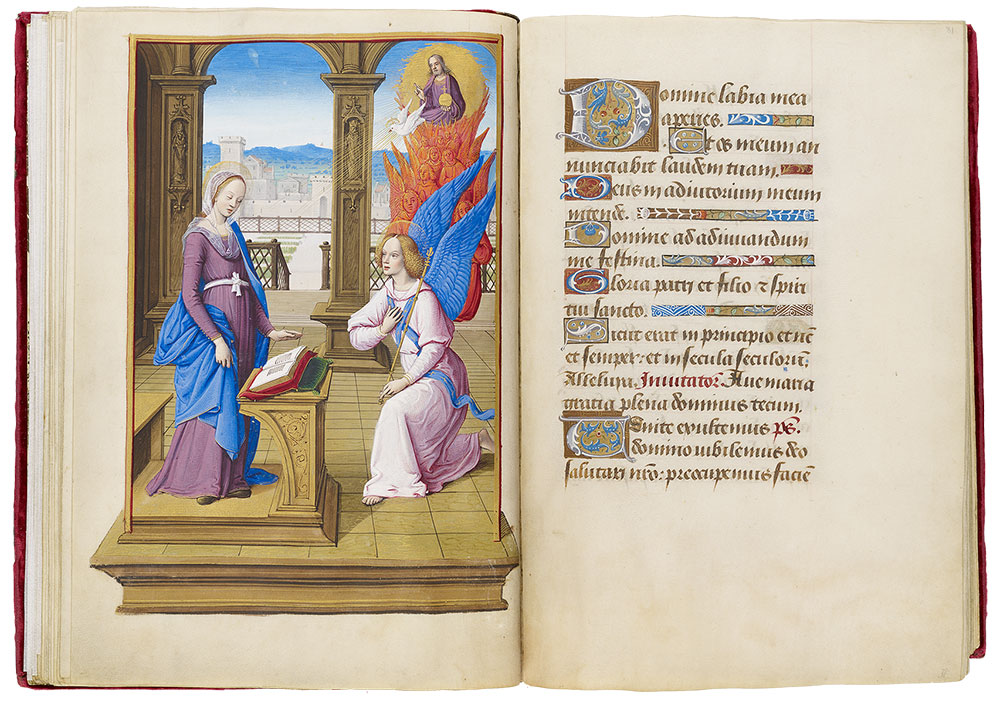
Matins: Annunciation
Hours of Henry VIII
Illuminated by Jean Poyer
Gift of the Heineman Foundation, 1977
Matins: Annunciation (fol. 30v)
The traditional opening miniature in most Hours of the Virgin is the Annunciation. We are about to witness the Incarnation of Christ, when the eternal Son of God took human flesh from his human mother.
The Annunciation takes place in an open portico, whose two arches frame and heighten the figures, while diagonals and orthogonals lead the eye into the garden and distant city, offering testimony to Poyer's legendary skill in the use of perspective.
God the Father, in a flaming aureole supported by a choir of red angels, dispatches the Holy Spirit in the form of a dove, who follows a path of golden rays toward the Virgin. While Poyer may have intended the red angels to be seraphim, the highest order of angels and those closest to God, he gave them full bodies and one rather than three pairs of wings.
Mary, who stands rather than kneels, has her eyes turned downward on an open book in a red chemise binding supported by a green cushion. In Annunciations from the late Middle Ages, these books take on the shape of a Book of Hours. Indeed, the manuscript shown here, in size and layout, is much like the Hours of Henry VIII.
Gabriel, on one knee, holds a scepter surmounted with a fleur- de-lis and wears an alb and a blue stole ornamented with gold crosses, anticipating the priestly vestments worn at Mass and when handling the Blessed Sacrament. (The Eucharist is believed to be the real presence of the Body and Blood of Christ, the human form assumed by God at the Incarnation.)
Hours of the Virgin (fols. 30v–93v)
The Hours of the Virgin are the core text of a Book of Hours and, as their title indicates, are devoted to Mary, the Mother of God. Their importance, moreover, is signaled in the Hours of Henry VIII both by length (some sixty folios) and the richness of its illumination, which includes more than half of the manuscript's full-page miniatures.
MS H.8, fols. 31v–32r
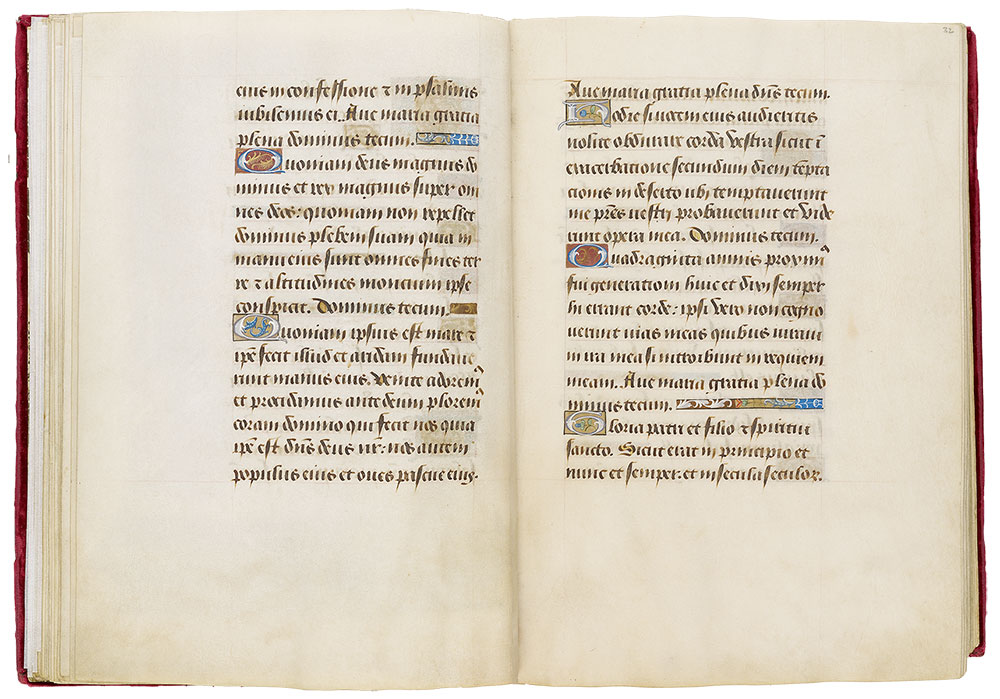
Hours of Henry VIII
Illuminated by Jean Poyer
Gift of the Heineman Foundation, 1977
MS H.8, fols. 32v–33r
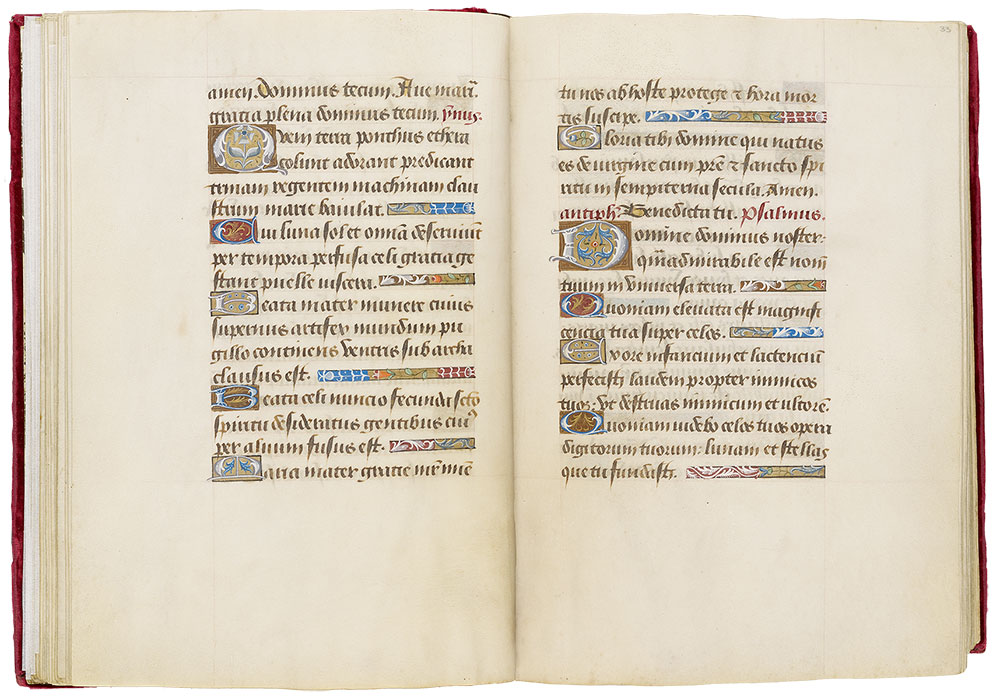
Hours of Henry VIII
Illuminated by Jean Poyer
Gift of the Heineman Foundation, 1977
MS H.8, fols. 33v–34r
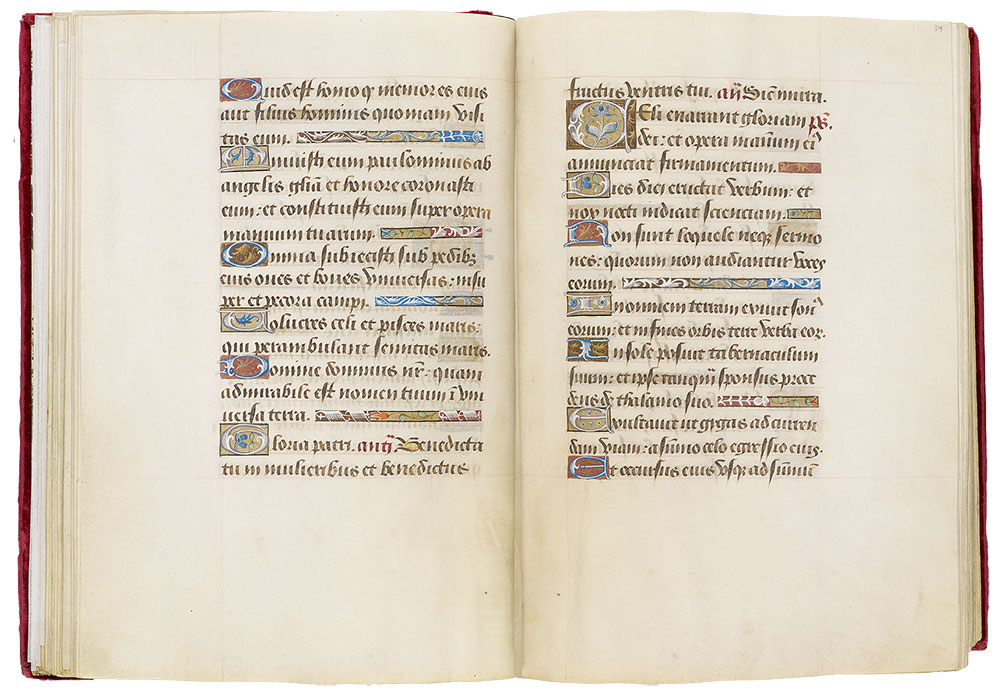
Hours of Henry VIII
Illuminated by Jean Poyer
Gift of the Heineman Foundation, 1977
MS H.8, fols. 34v–35r
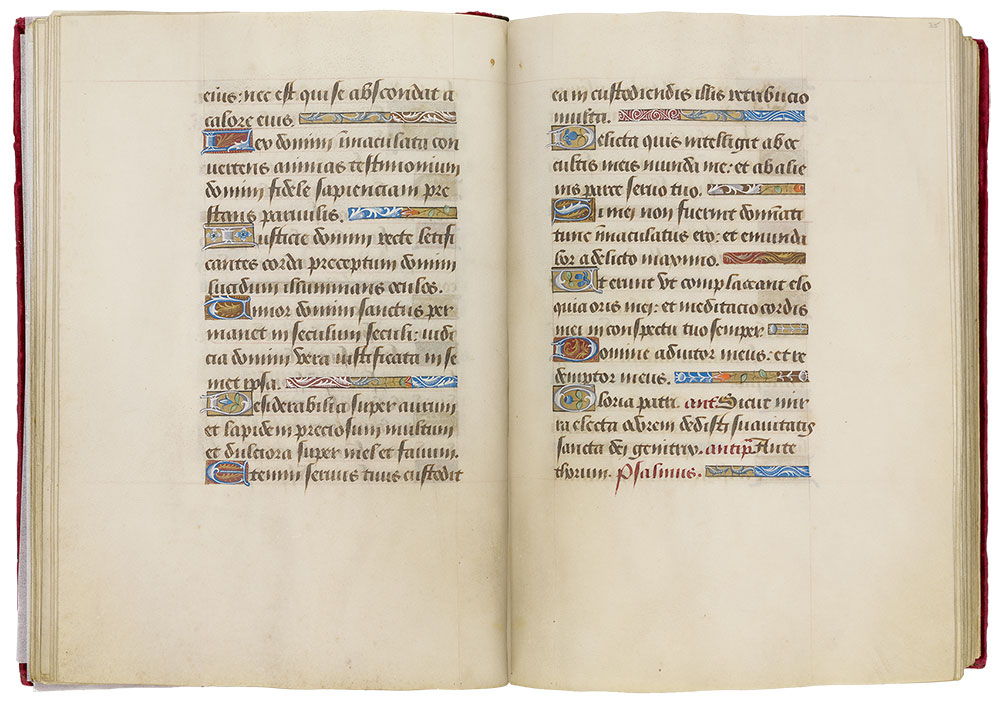
Hours of Henry VIII
Illuminated by Jean Poyer
Gift of the Heineman Foundation, 1977
MS H.8, fols. 35v–36r
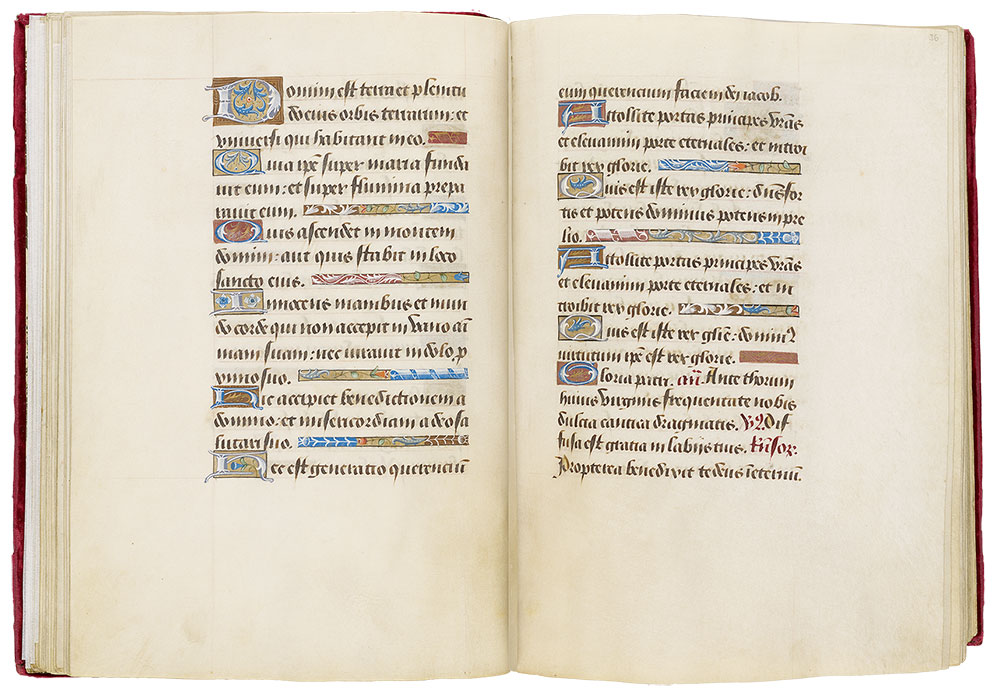
Hours of Henry VIII
Illuminated by Jean Poyer
Gift of the Heineman Foundation, 1977
MS H.8, fols. 36v–37r
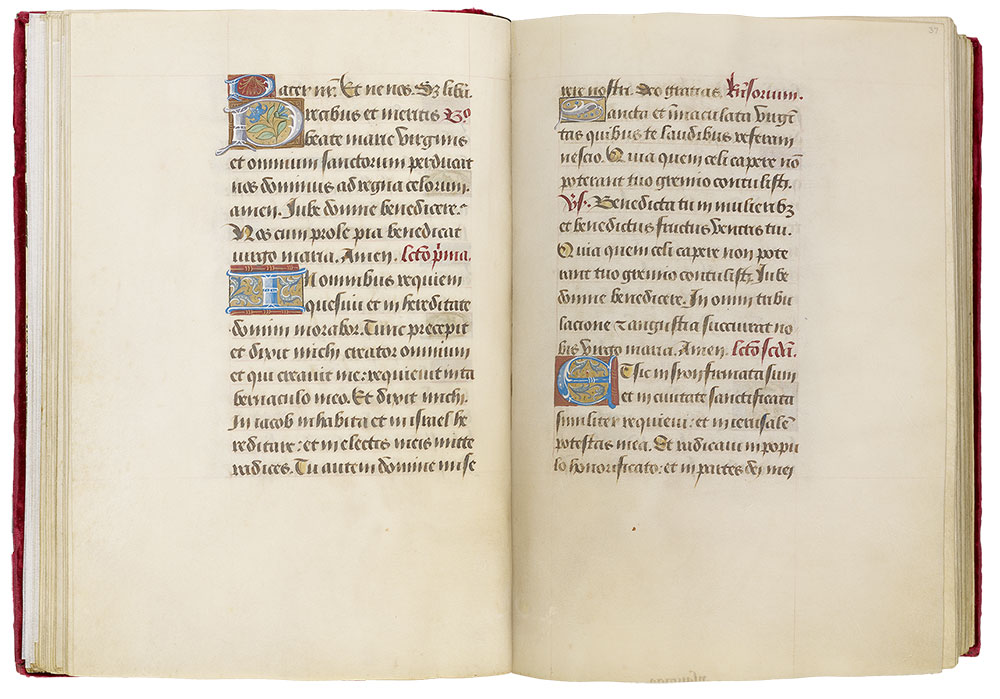
Hours of Henry VIII
Illuminated by Jean Poyer
Gift of the Heineman Foundation, 1977
MS H.8, fols. 37v–38r
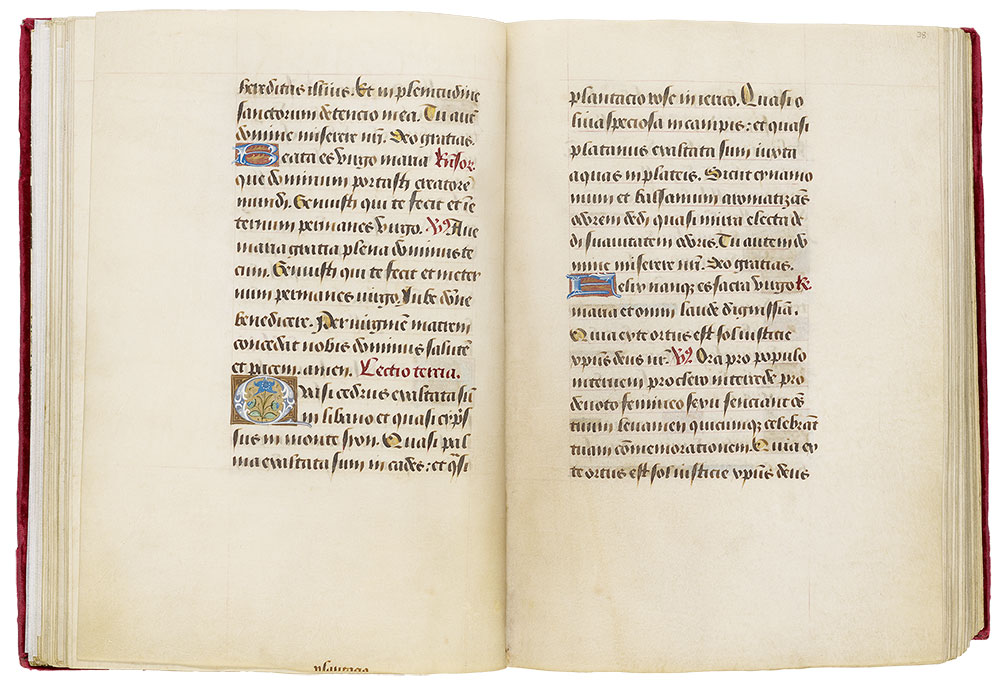
Hours of Henry VIII
Illuminated by Jean Poyer
Gift of the Heineman Foundation, 1977
MS H.8, fols. 38v–39r
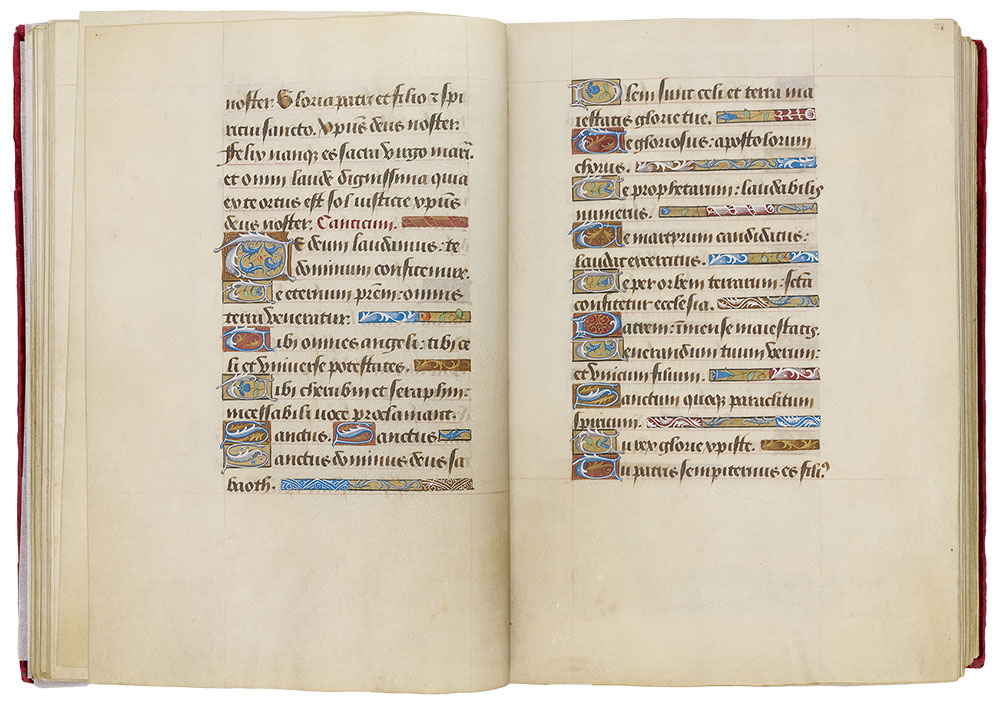
Hours of Henry VIII
Illuminated by Jean Poyer
Gift of the Heineman Foundation, 1977
MS H.8, fols. 39v–40r
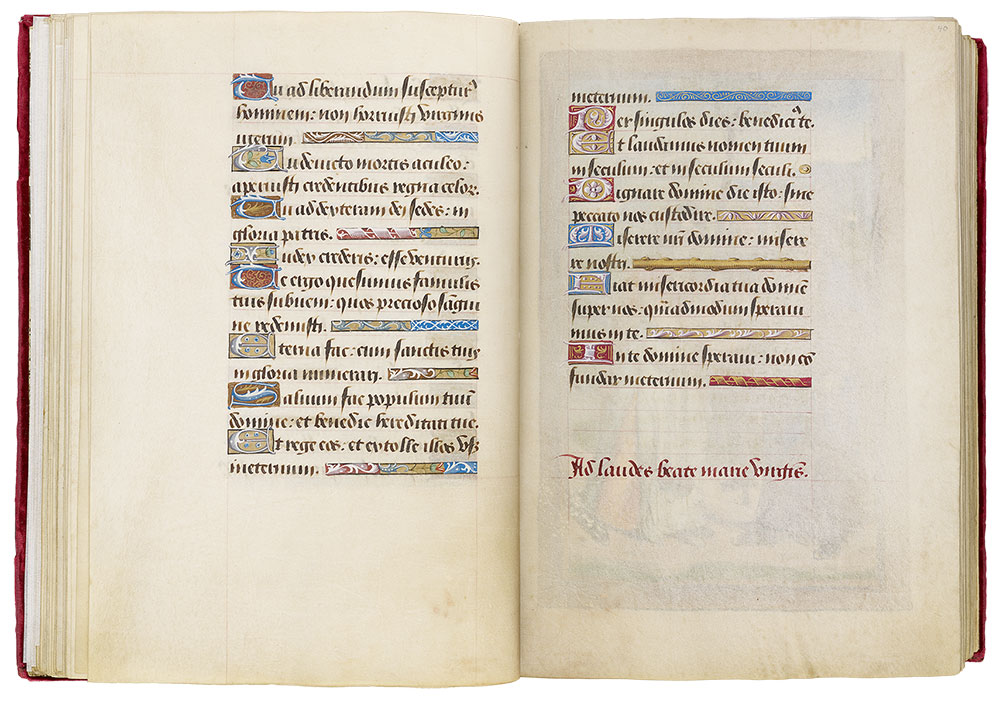
Hours of Henry VIII
Illuminated by Jean Poyer
Gift of the Heineman Foundation, 1977
MS H.8, fols. 40v–41r
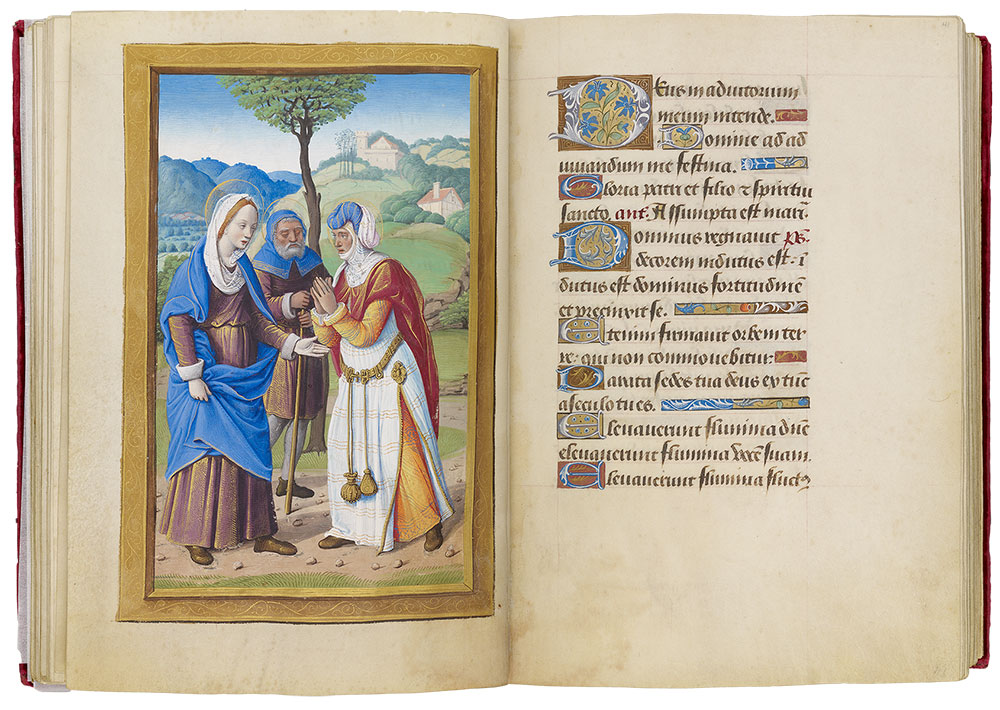
Lauds: Visitation
Hours of Henry VIII
Illuminated by Jean Poyer
Gift of the Heineman Foundation, 1977
Lauds: Visitation (fol. 40v)
According to Luke (1:36–56), Gabriel also told the Virgin that her cousin Elizabeth, in her old age, also had conceived a son. Soon thereafter, to rejoice, Mary went to visit her cousin, who was six months pregnant with John the Baptist. (Elizabeth was barren until Gabriel appeared to Zacharias, her husband, telling him that his wife would bear him a son that he should name John.)
The burlet on Elizabeth's head, as well as the two purses hanging from her elaborate gold belt, give her an exotic appearance. The man standing behind the pair—his eyes half shut—is Joseph.
When the Virgin entered Elizabeth's house and greeted the infant John leaped in her womb and she was filled with the Holy Spirit. Here, however, as this scene is usually depicted, the meeting takes place outdoors; the Virgin extends her hand to Elizabeth, who folds her hands in prayerful recognition of the forthcoming Savior.
MS H.8, fols. 41v–42r
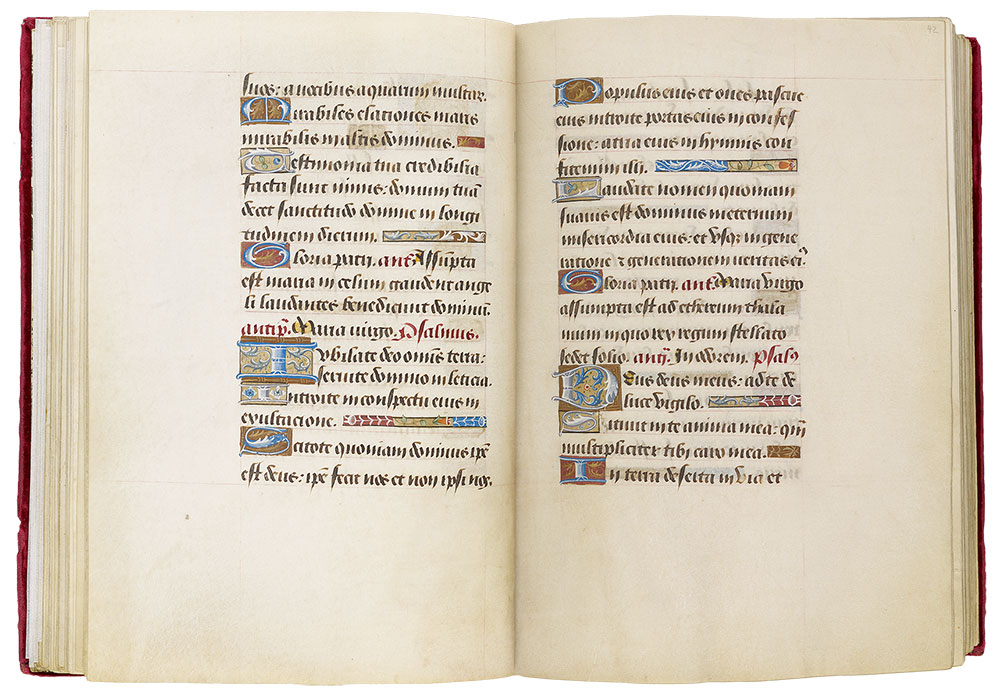
Hours of Henry VIII
Illuminated by Jean Poyer
Gift of the Heineman Foundation, 1977
MS H.8, fols. 42v–43r
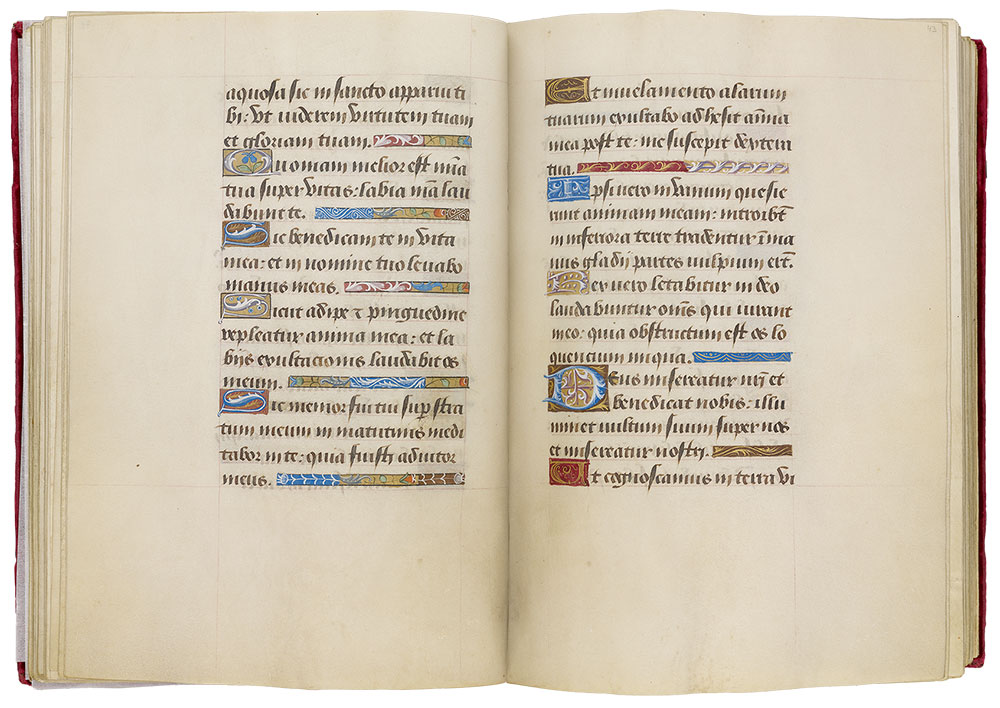
Hours of Henry VIII
Illuminated by Jean Poyer
Gift of the Heineman Foundation, 1977
MS H.8, fols. 43v–44r
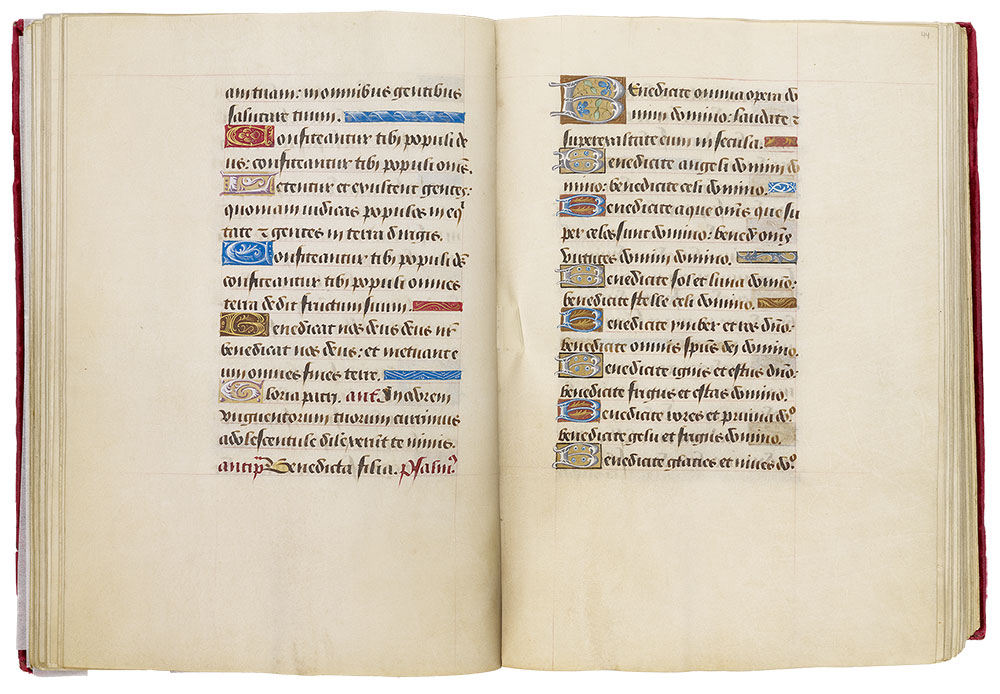
Hours of Henry VIII
Illuminated by Jean Poyer
Gift of the Heineman Foundation, 1977
MS H.8, fols. 44v–45r
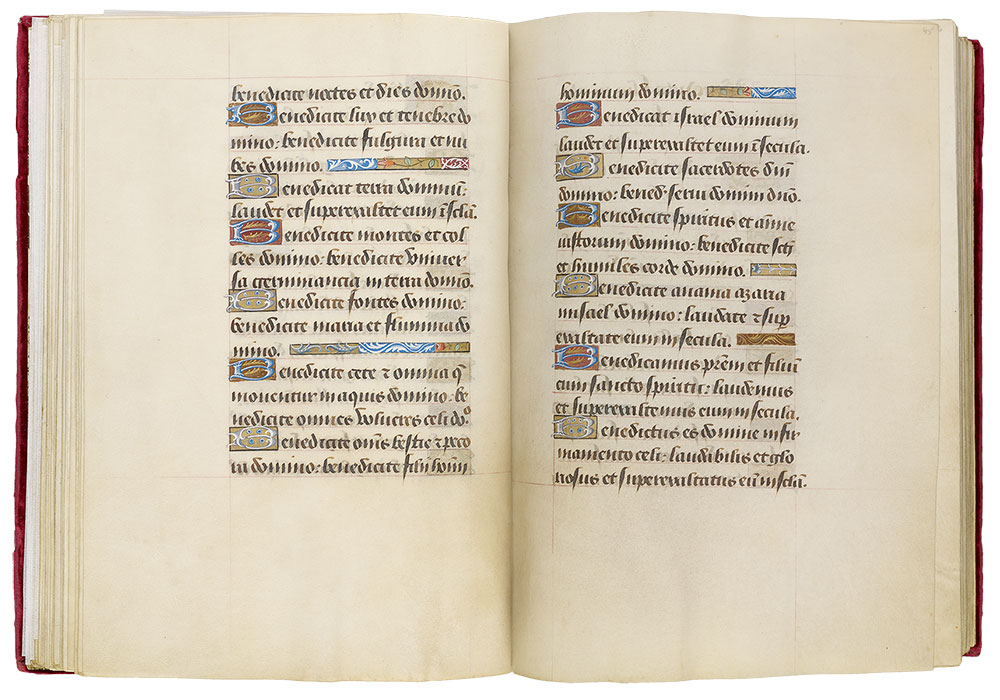
Hours of Henry VIII
Illuminated by Jean Poyer
Gift of the Heineman Foundation, 1977
MS H.8, fols. 45v–46r
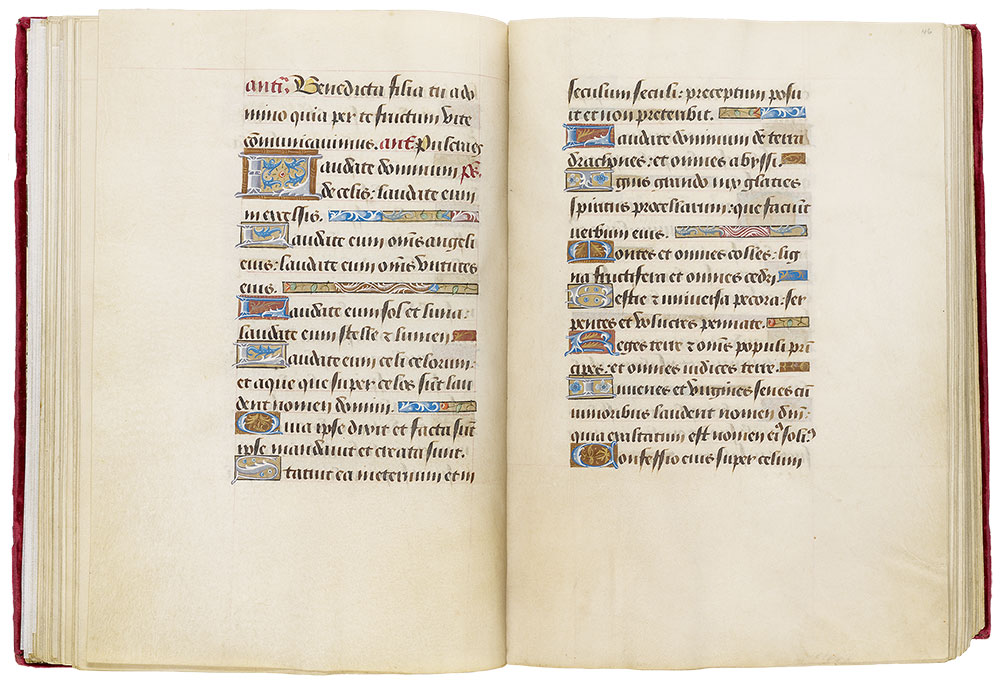
Hours of Henry VIII
Illuminated by Jean Poyer
Gift of the Heineman Foundation, 1977
MS H.8, fols. 46v–47r
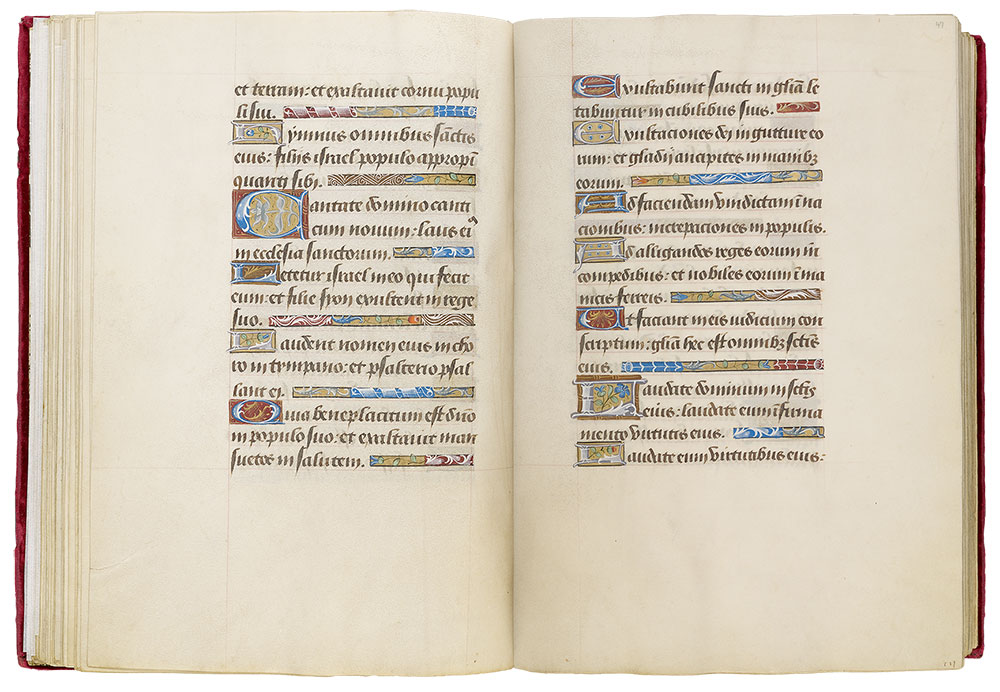
Hours of Henry VIII
Illuminated by Jean Poyer
Gift of the Heineman Foundation, 1977
MS H.8, fols. 47v–48r
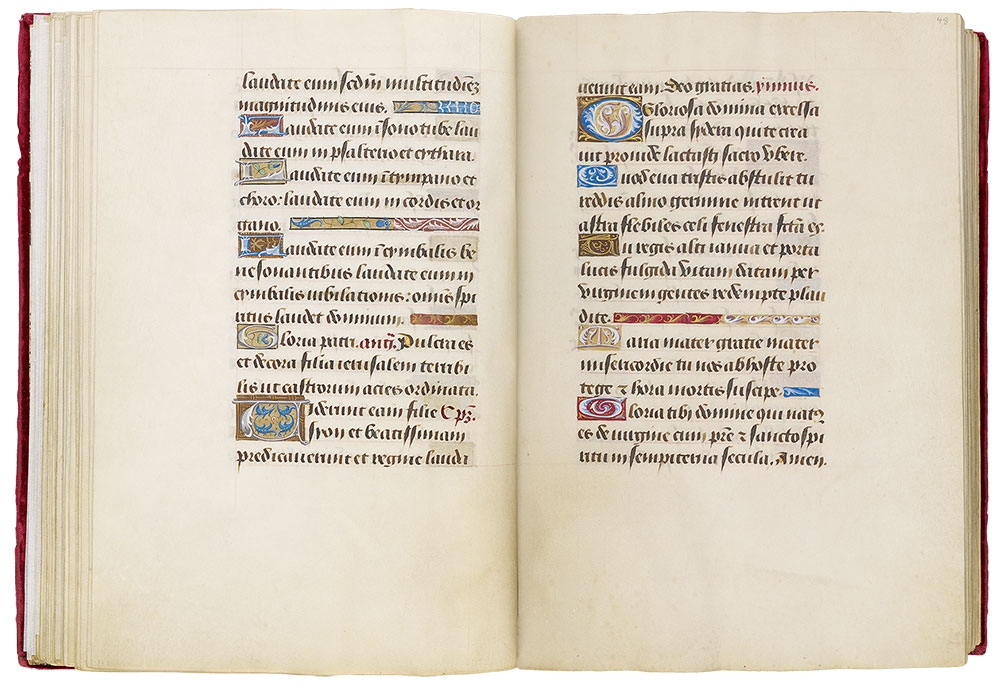
Hours of Henry VIII
Illuminated by Jean Poyer
Gift of the Heineman Foundation, 1977
MS H.8, fols. 48v–49r
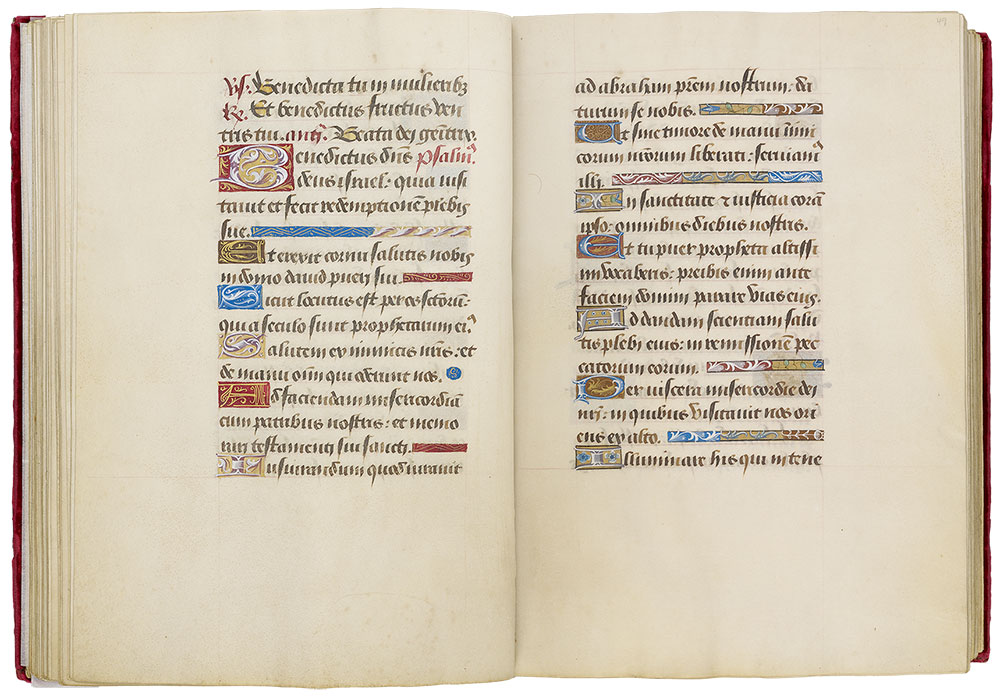
Hours of Henry VIII
Illuminated by Jean Poyer
Gift of the Heineman Foundation, 1977
MS H.8, fols. 49v–50r
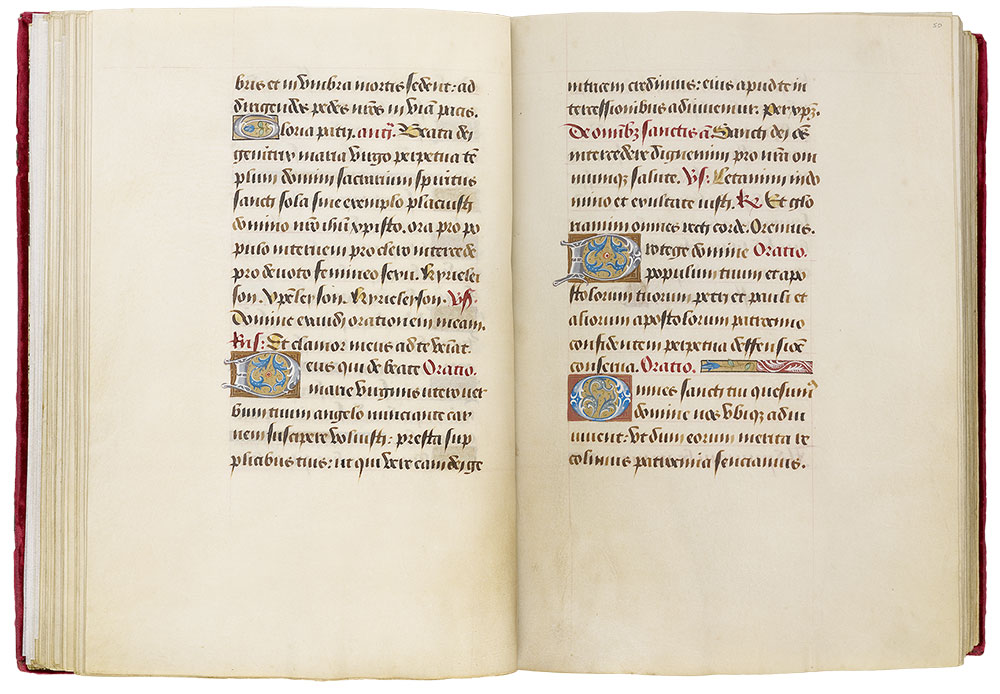
Hours of Henry VIII
Illuminated by Jean Poyer
Gift of the Heineman Foundation, 1977
MS H.8, fols. 50v–51r
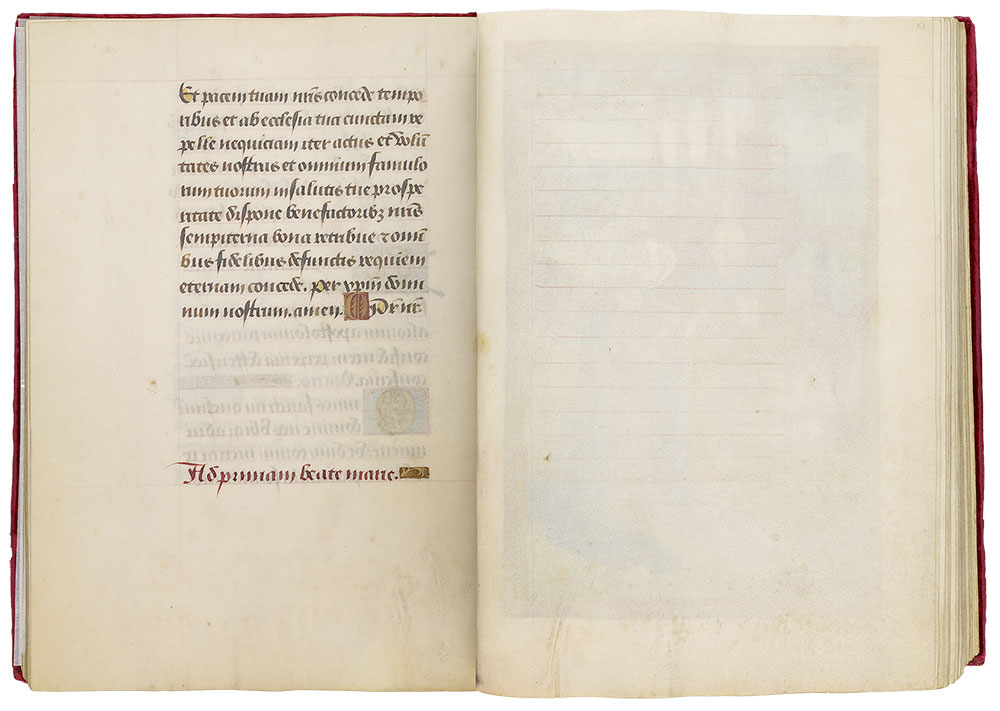
Hours of Henry VIII
Illuminated by Jean Poyer
Gift of the Heineman Foundation, 1977
MS H.8, fols. 51v–52r
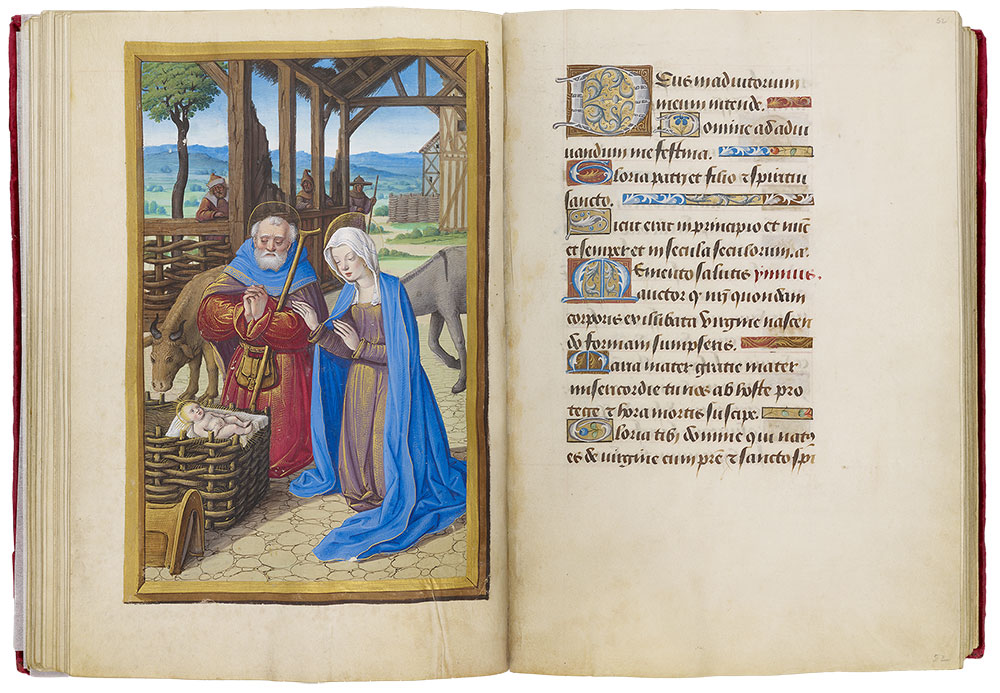
Prime: Nativity
Hours of Henry VIII
Illuminated by Jean Poyer
Gift of the Heineman Foundation, 1977
Prime: Nativity (fol. 51v)
Of the four evangelists, only Luke (2:7) provides details, though scant, concerning the Nativity: "And she brought forth her firstborn son, and wrapped him in swaddling clothes, and laid him in a manger, because there was no room for them in the inn." Here, however, the child is shown naked, revealing his maleness, and golden rays emanate from his body.
Details about the Nativity derive from the Revelations of St. Bridget of Sweden (c. 1303–73), which influenced depictions of the Birth of Christ in the fifteenth and sixteenth centuries. According to Bridget, an ineffable light and splendor radiated from the child. In her description of the scene, St. Bridget notes that the shepherds—three are peering from the background—uninformed whether the child was male or female, wished to confirm that the child was indeed male; they knew that the Messiah should be a son.
The presence of the ox and ass, not mentioned by the Gospels but included by Bridget, had already been exegetically connected with the Nativity because they were thought to fulfill the prophecy of Isaiah (1:3) that the "ox knoweth his owner, and the ass his master's crib."
Sometimes, as here, the animals are not equal witnesses, but represent the contrast between the Old and New Dispensation, or the Old and New Law. The ox, symbolizing the New Law (of Christ) knowingly looks on, while the view of the other, the Old Law (of Moses), is obscured behind the Virgin, and thus uncomprehending. After the birth, said Bridget, the Virgin immediately worshiped the child, as did Joseph.
The partially obscured object in the lower left corner is the saddle upon which Mary rode during her trip to Bethlehem, where the prophets said that the Messiah would be born.
MS H.8, fols. 52v–53r
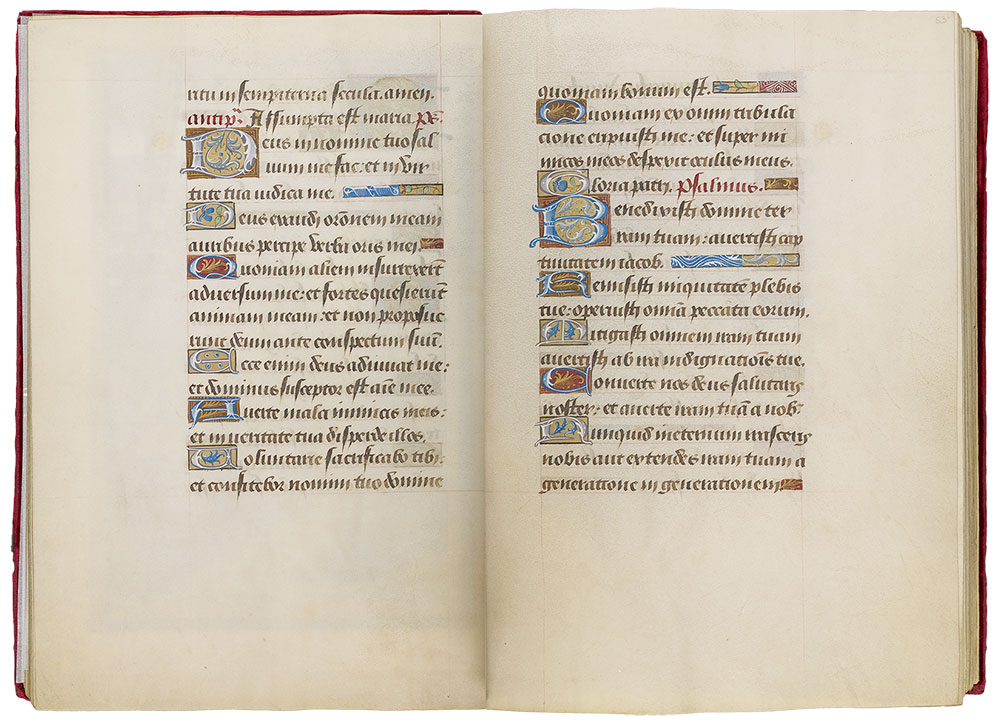
Hours of Henry VIII
Illuminated by Jean Poyer
Gift of the Heineman Foundation, 1977
MS H.8, fols. 53v–54r
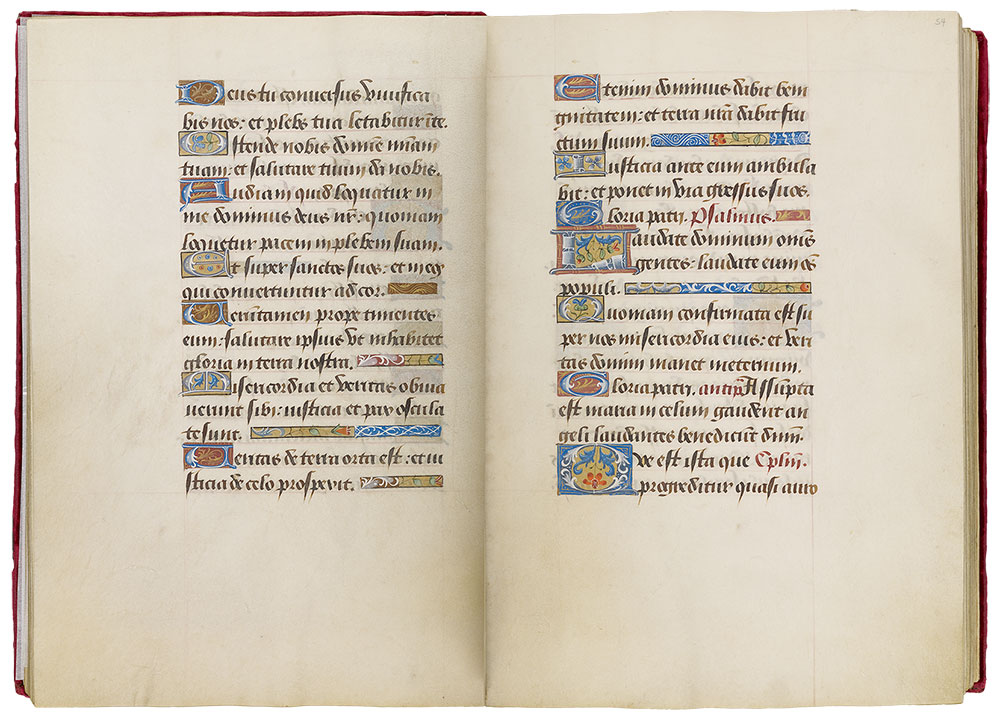
Hours of Henry VIII
Illuminated by Jean Poyer
Gift of the Heineman Foundation, 1977
MS H.8, fols. 54v–55r
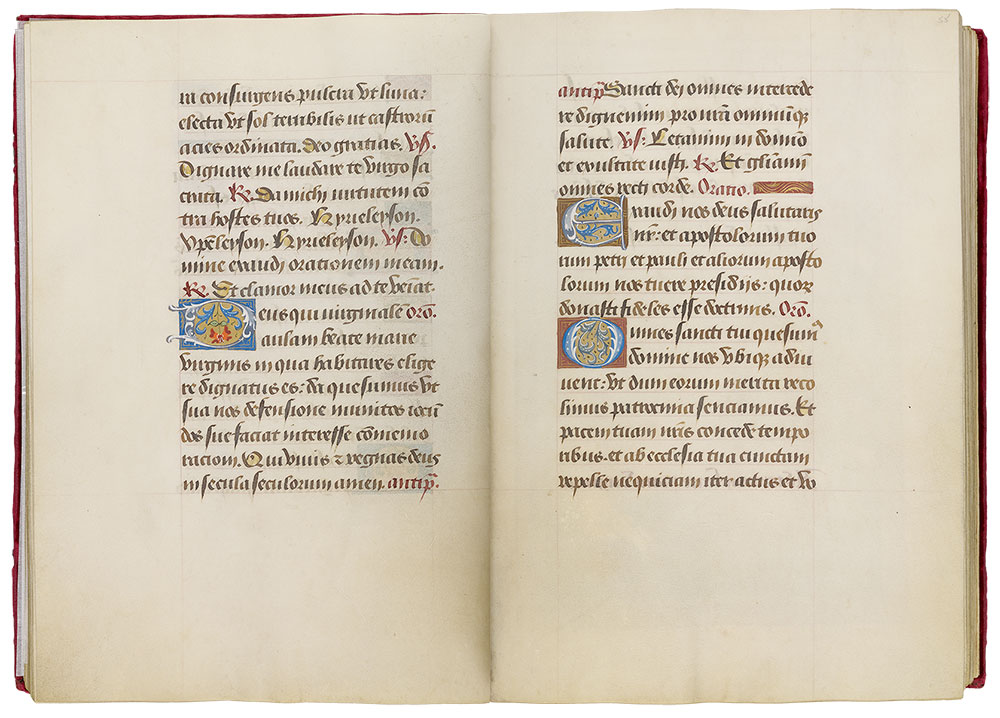
Hours of Henry VIII
Illuminated by Jean Poyer
Gift of the Heineman Foundation, 1977
MS H.8, fols. 55v–56r
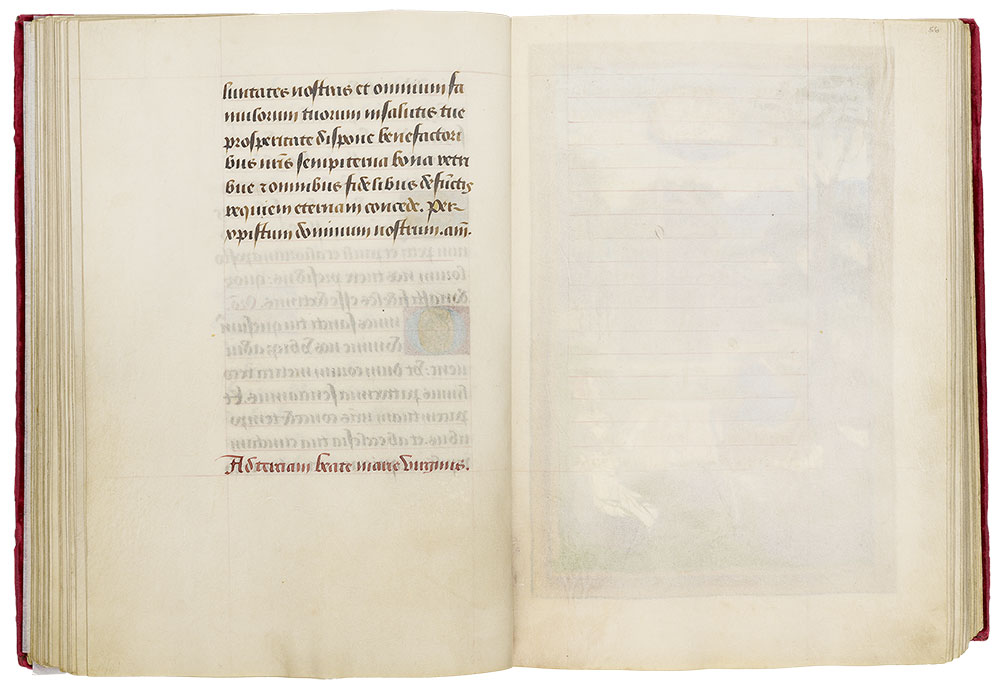
Hours of Henry VIII
Illuminated by Jean Poyer
Gift of the Heineman Foundation, 1977
MS H.8, fols. 56v–57r
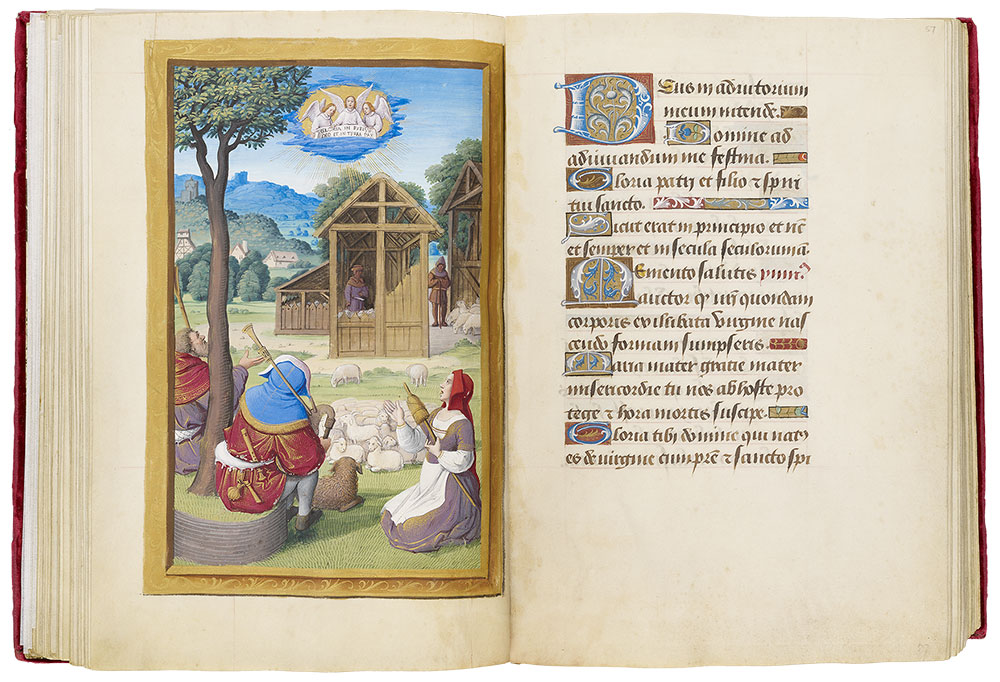
Terce: Annunciation to the Shepherds
Hours of Henry VIII
Illuminated by Jean Poyer
Gift of the Heineman Foundation, 1977
Terce: Annunciation to the Shepherds (fol. 56v)
The Annunciation to the Shepherds, like the Nativity, is only recounted by Luke (2:8–14). Poyer, however, chose not to emphasize the nocturnal appearance of the single annunciatory angel amid the brightness of God but the later moment when the angel, joined by others from the heavenly hosts, sang the familiar "Glory to God in the Highest, and peace on earth to men of good will."
Poyer illustrates the Angels of the Annunciation singing their familiar "Glory to God in the Highest, and on earth peace to men of good will" by adding the text on the scroll that they present: Gloria in exelssi [sic: excelsis] Deo et in terra pax.
Wooden sheds in the background contain more sheep and two shepherds who are not yet aware of the angel's good tidings.
Three shepherds in the fore- ground, seen from the back or side, look up and receive the tidings. One holds a staff while another with a bagpipe has a second instrument—a flute— tucked into his belt; the shepherdess holds a distaff.
One wonders if the solitary and prominently placed goat amid the sheep would have recalled Matthew 25:32, where the future Son of Man would come to judge and separate the blessed from the evil, "just as the shepherd separates the sheep from the goats."
MS H.8, fols. 57v–58r
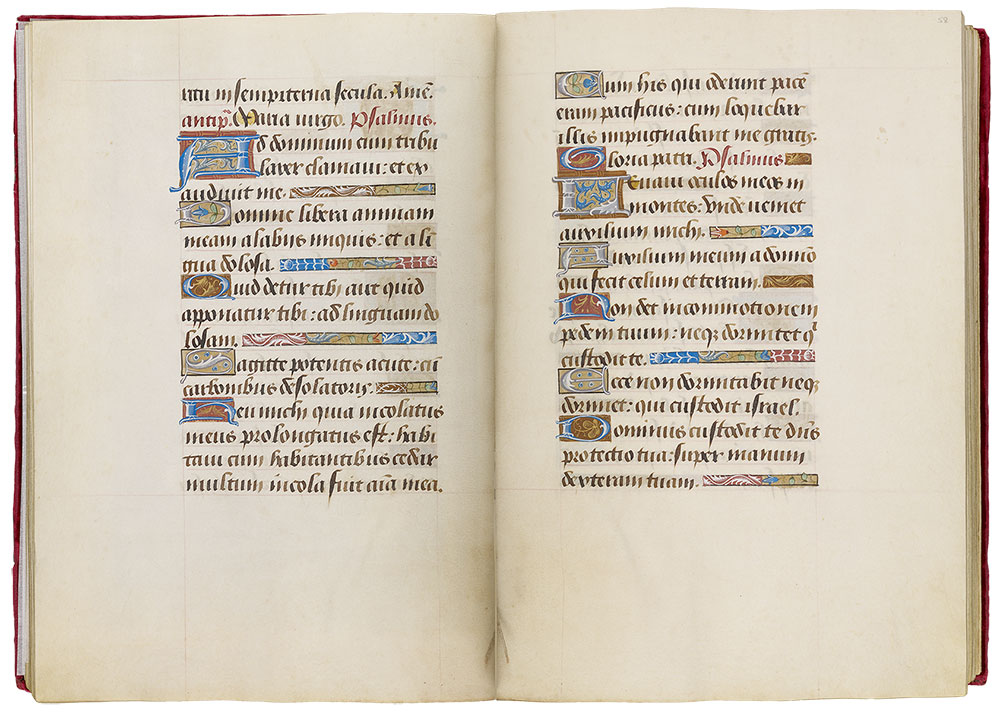
Hours of Henry VIII
Illuminated by Jean Poyer
Gift of the Heineman Foundation, 1977
MS H.8, fols. 58v–59r
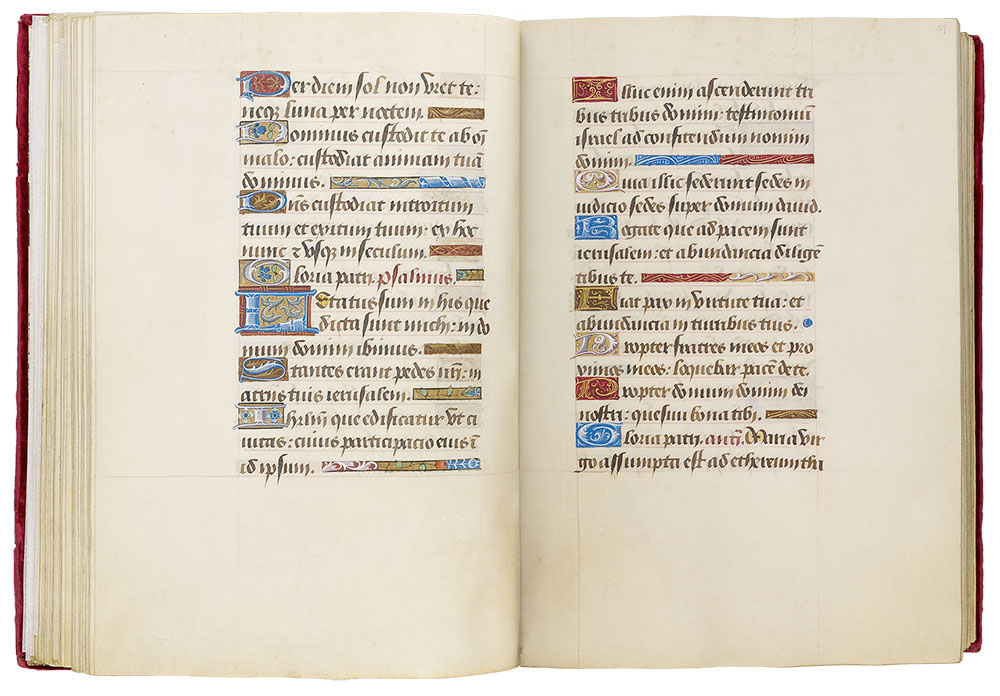
Hours of Henry VIII
Illuminated by Jean Poyer
Gift of the Heineman Foundation, 1977
MS H.8, fols. 59v–60r
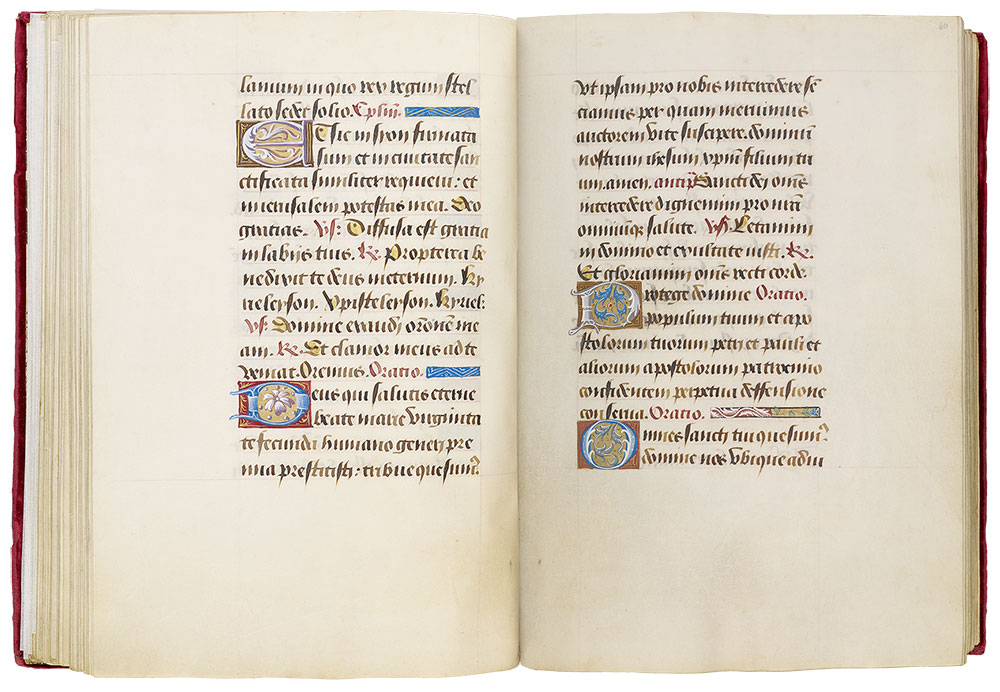
Hours of Henry VIII
Illuminated by Jean Poyer
Gift of the Heineman Foundation, 1977
MS H.8, fols. 60v–61r
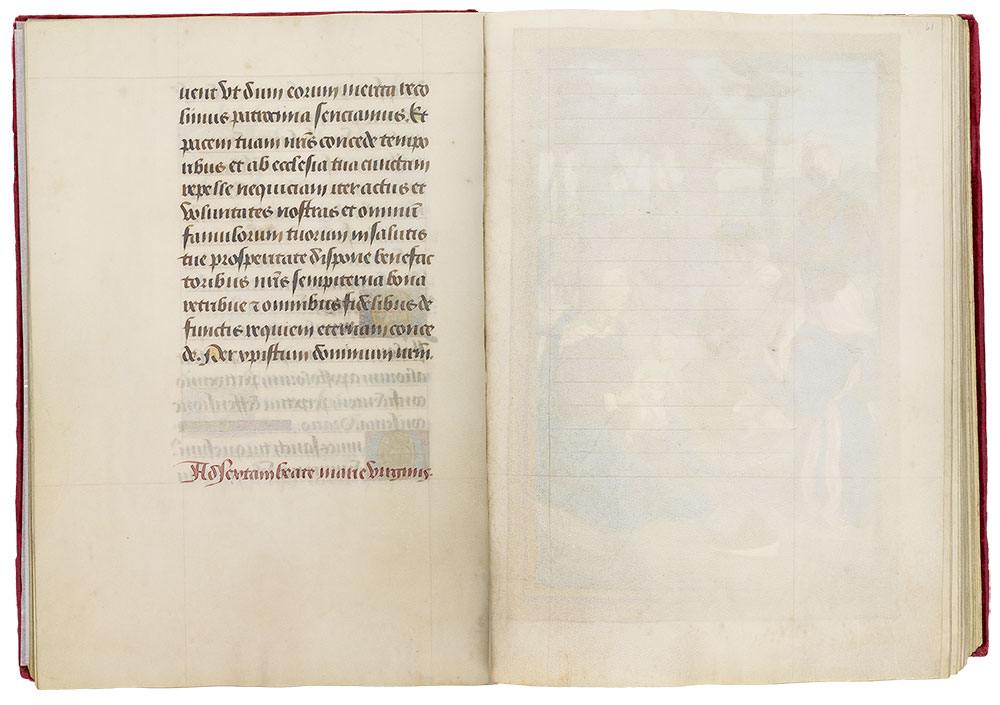
Hours of Henry VIII
Illuminated by Jean Poyer
Gift of the Heineman Foundation, 1977
MS H.8, fols. 61v–62r
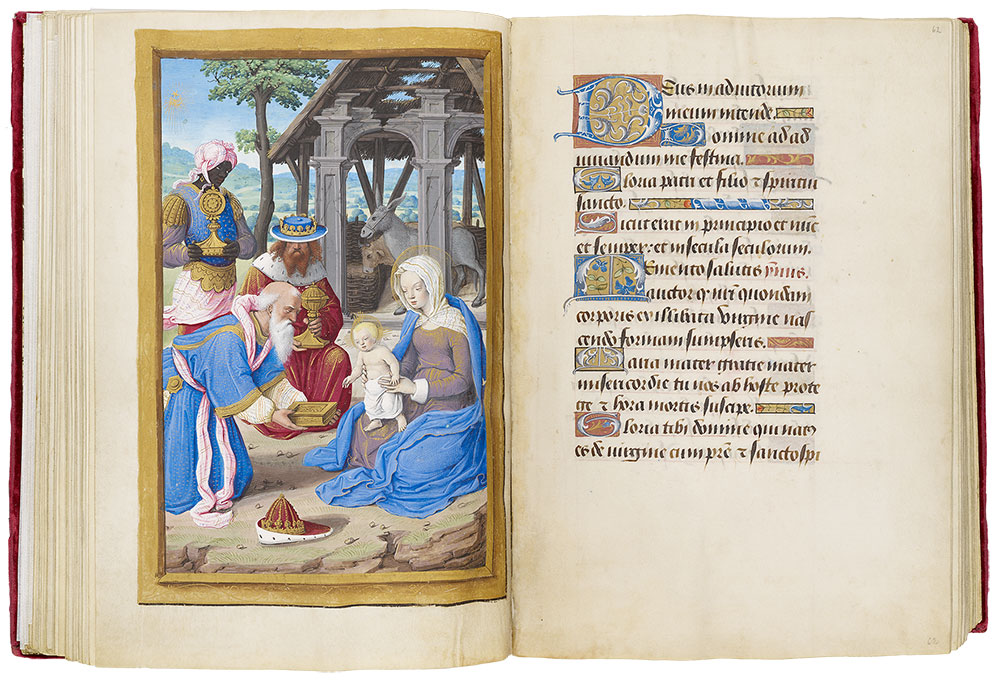
Sext: Adoration of the Magi
Hours of Henry VIII
Illuminated by Jean Poyer
Gift of the Heineman Foundation, 1977
Sext: Adoration of the Magi (fol. 61v)
In Poyer's Adoration, the Virgin, in an act of humility, sits on the ground as each of the Magi presents his gift to the child standing on her lap. The innate nobility of the Magus is achieved by some of Poyer's most inspired painting, especially evident in his closely observed facial features, gold earring, and exotic turban.
Caspar, the name supplied for the oldest Magus, has removed his crown in deference to Christ as King, kneels and presents gold; the second, holding a chalice with incense, waits his turn; while the youngest, still at a distance, stands erect and holds a monstrance.
Poyer designed his compositions like stage sets: the ruinous stone arches of the stable will reappear in the Massacre of the Innocents (cf. folio 69v), and the ox and ass eat hay from the wattled manger that previously served as Christ's cradle.
In the later Middle Ages, when the Magi were connected with the three continents known then (Europe, Africa, Asia), Balthazar was increasingly depicted as a black man. In some late- fifteenth-century paintings, however, as here, it was the youngest Magus who was so depicted.
Adoration of the Magi
According to the Gospel of Matthew (2:1–12), wise men from the East who saw the star signifying the birth of the King of the Jews went to adore him at Jerusalem, only to discover that he was born in Bethlehem (fulfilling the prophecy of Micheas 5:2). Since the wise men offered three gifts—gold, frankincense, and myrrh—it was assumed as early as the third century that they were three; about the same time they were redefined as kings, and by the ninth century they were supplied with the familiar names of Caspar (the oldest), Balthazar, and Melchior (the youngest). In the later Middle Ages, when the Magi were connected with the three continents known then (Europe, Africa, Asia), Balthazar was increasingly depicted as a black man. Their gifts were also given various explanations. According to St. Bernard of Clairvaux (1090–1153), the gold gave testimony to the Virgin's poverty, the incense purified the smell of the stable, and myrrh strengthened the child's limbs (driving out the worms from his entrails). For the Venerable Bede (672/73–735) they signified the royalty, divinity, and humanity of Christ: gold for royal tribute to the highest king; incense for divine worship since he was God; and myrrh for burial, foreshadowing his own death, since he was a mortal man. These explanations were popularized in printed editions of the Golden Legend (compiled by Jacobus de Voragine before 1267).
MS H.8, fols. 62v–63r
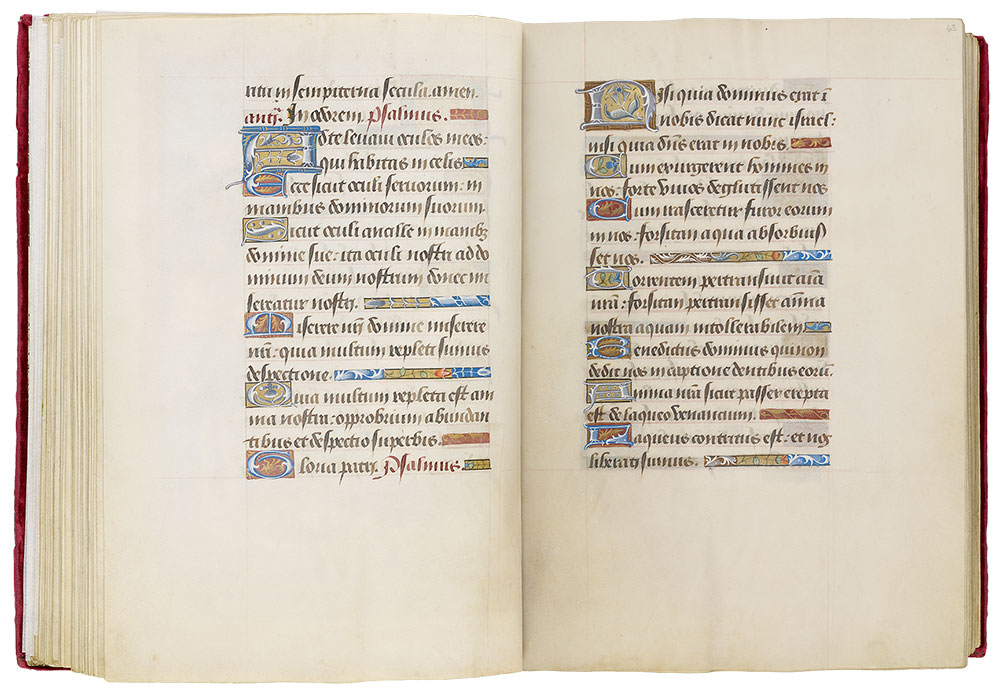
Hours of Henry VIII
Illuminated by Jean Poyer
Gift of the Heineman Foundation, 1977
MS H.8, fols. 63v–64r
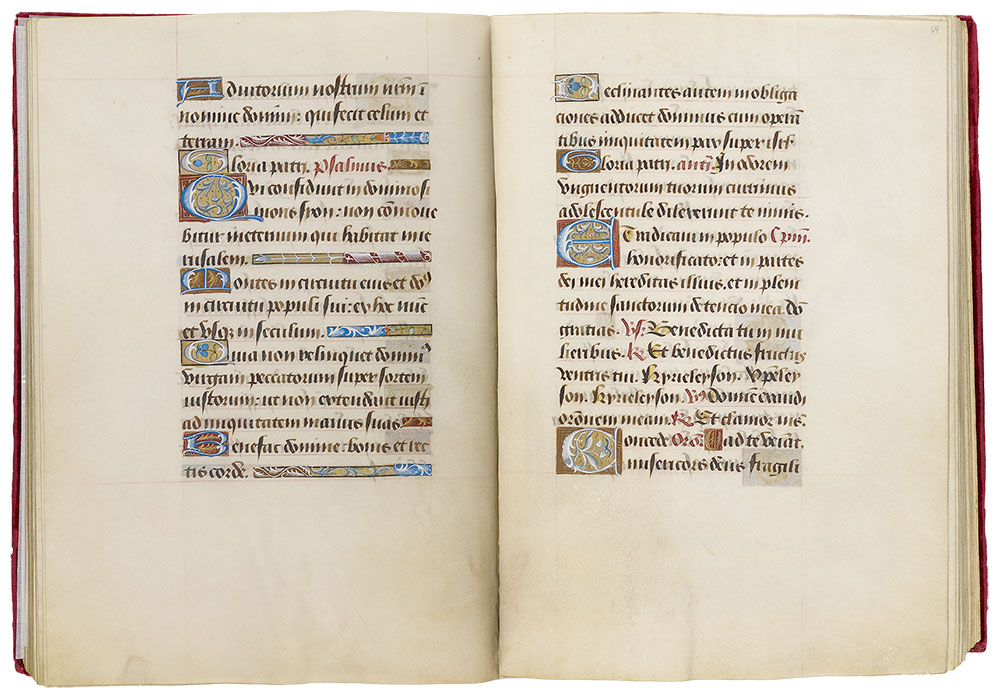
Hours of Henry VIII
Illuminated by Jean Poyer
Gift of the Heineman Foundation, 1977
MS H.8, fols. 64v–65r
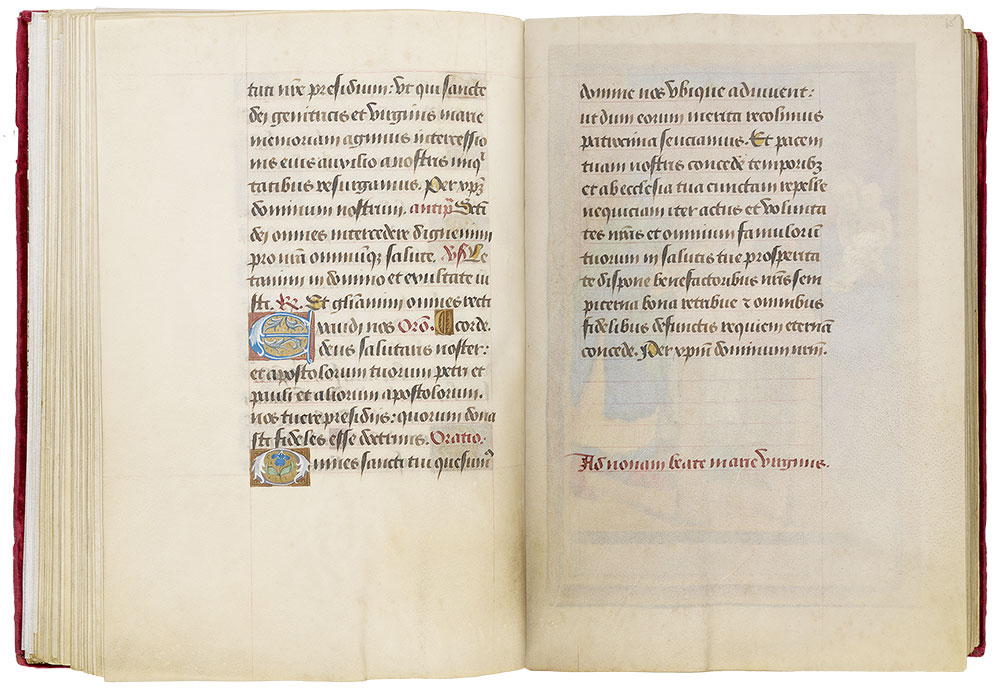
Hours of Henry VIII
Illuminated by Jean Poyer
Gift of the Heineman Foundation, 1977
MS H.8, fols. 65v–66r
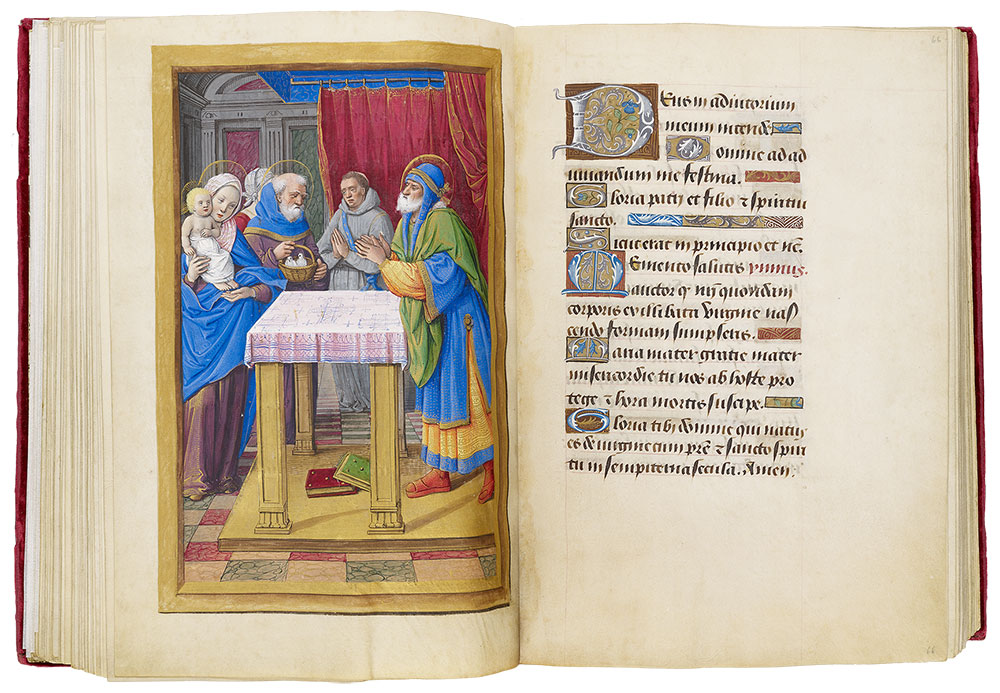
None: Presentation in the Temple
Hours of Henry VIII
Illuminated by Jean Poyer
Gift of the Heineman Foundation, 1977
None: Presentation in the Temple (fol. 65v)
The traditional illustration for None is the Presentation of Christ in the Temple. According to Luke (2:22–40), the Holy Family would be met by Simeon, who was inspired by the Holy Spirit to recognize, before his own death, the Savior.
The altar itself, complete with a blue canopy and red curtains, is situated within a Renaissance interior with walls decorated with pilasters framing large red and green marble panels, echoing the rows of colored floor marbles. The five large crosses that decorate the altar cloth, suggesting the five wounds Christ would endure on the Cross, may allude to Simeon's vision.
As was common in later medieval art, Poyer has identified Simeon with the high priest of the Temple; he would proclaim that the Lord could now let him depart in peace, having seen his salvation. The famous Canticle of Simeon, beginning Nunc dimittis (Now you may dismiss me), does occur in the Hours of the Virgin but at Compline. Poyer has given him a halo because he was subsequently made a saint; the letters on the hem of his garment suggest Hebrew. After blessing the Holy Family, Simeon told Mary that her child was set for the fall and resurrection of many in Israel and a sword would pierce her own soul.
The unusual presence of a Franciscan friar behind the altar suggests that the original owner may have had some connection or special devotion to that order, which was especially favored by French royalty at this time. The manuscript's Calendar has a strong emphasis on Franciscans. They were known as Gray Friars because of the color of their habit, which was originally gray (but later brown).
Luke 2:22–40
The only biblical account for the Presentation of Christ in the Temple is Luke's (2:22–40): "After the days of her purification . . . they carried him to Jerusalem, to present him to the Lord . . . as it is written that every male opening the womb shall be called holy to the Lord, and to offer a sacrifice . . . a pair of turtledoves or two young pigeons." (The sacrificial birds, following Leviticus 12:6–8, were for the purification of women after childbirth.)
MS H.8, fols. 66v–67r
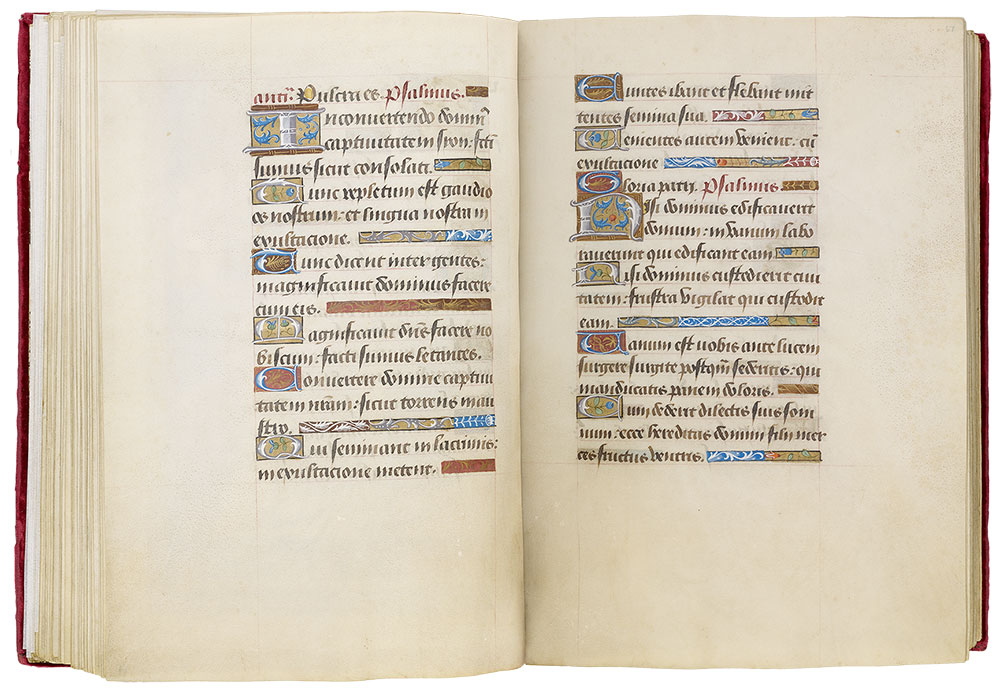
Hours of Henry VIII
Illuminated by Jean Poyer
Gift of the Heineman Foundation, 1977
MS H.8, fols. 67v–68r
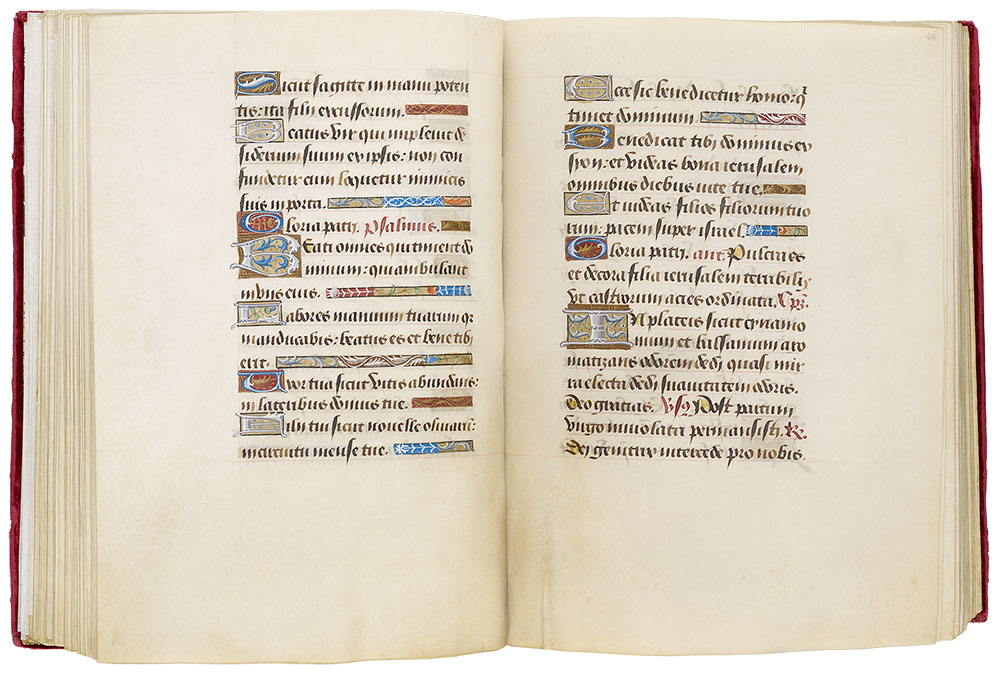
Hours of Henry VIII
Illuminated by Jean Poyer
Gift of the Heineman Foundation, 1977
MS H.8, fols. 68v–69r
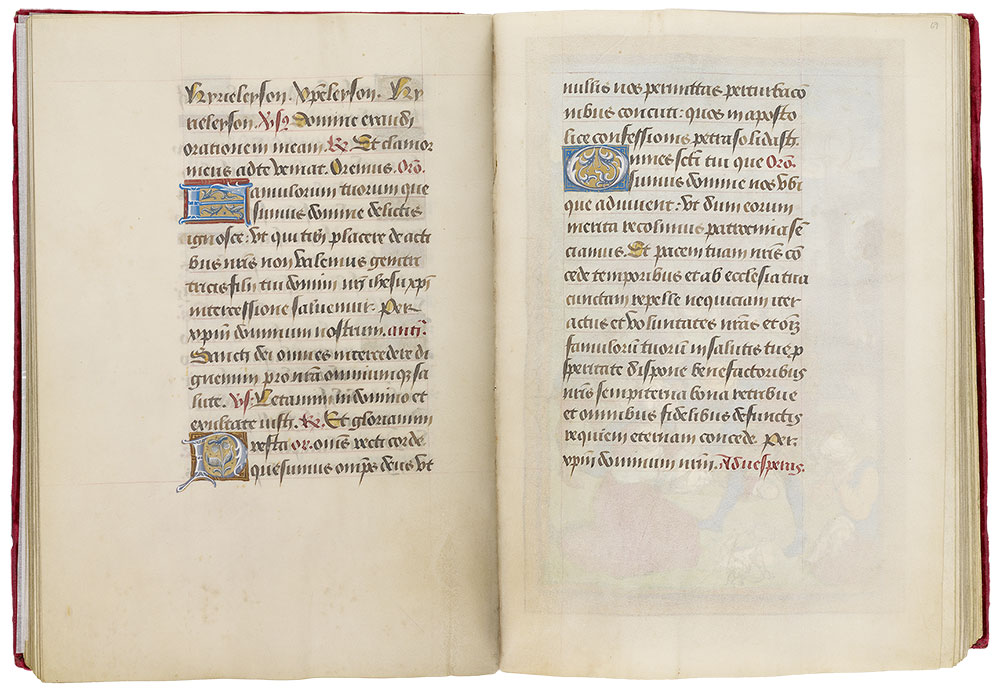
Hours of Henry VIII
Illuminated by Jean Poyer
Gift of the Heineman Foundation, 1977
MS H.8, fols. 69v–70r
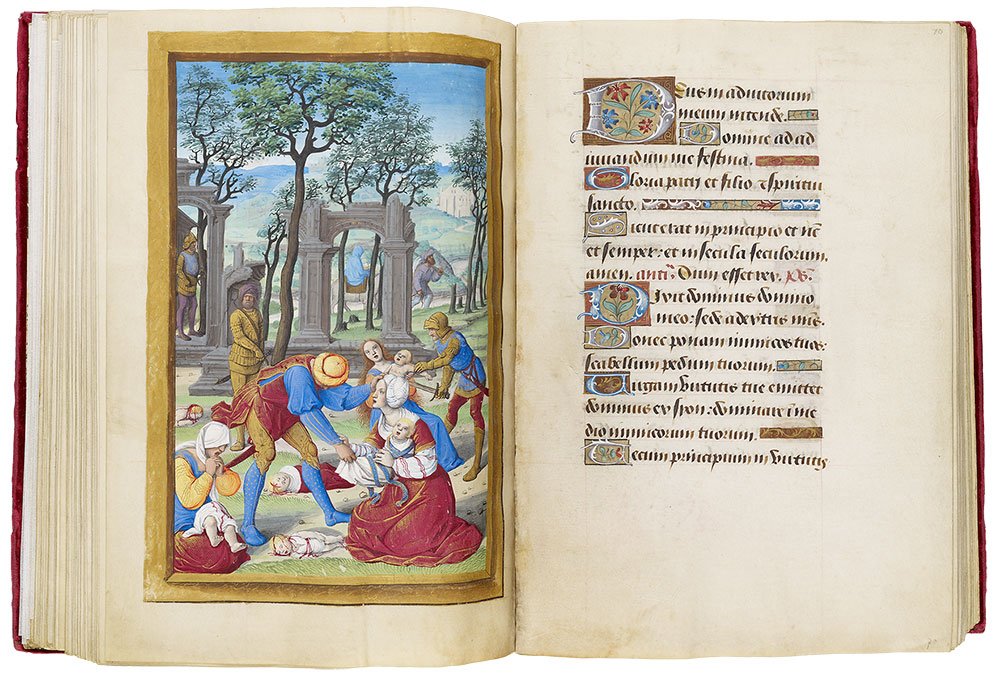
Vespers: Massacre of the Innocents and Flight into Egypt
Hours of Henry VIII
Illuminated by Jean Poyer
Gift of the Heineman Foundation, 1977
Vespers: Massacre of the Innocents and Flight into Egypt (fol. 69v)
While the Massacre of the Innocents is less common than the Flight into Egypt as the Vesper illustration, Poyer managed to include both. As the slaughter takes place in the foreground, the Holy Family departs for Egypt in the background—as can be seen through the stone ruins.
Two mothers futilely attempt to keep their children from soldiers, while a woman on the left wails uncontrollably over her dead baby. The Holy Innocents were regarded as the first martyrs, and their feast day (three days after Christmas) was already celebrated by the early Church.
Massacre of the Innocents
Following his unique account of the Adoration of the Magi, Matthew continues the narrative (2:13–18) with the Flight into Egypt and the Massacre of the Innocents. Herod, learning that a future ruler of Israel would come from Bethlehem, ordered the slaughter of all male children two years old and younger living in or near Bethlehem. An angel had already appeared to Joseph in his sleep, telling him to take Jesus and his mother to Egypt until the death of Herod. (Biblical scholars, including Matthew, have recognized that the Massacre and Flight provided the pretext for the fulfillment of Hosea's prophecy [Hosea 11:1] that, like Moses, the Messiah would come up out of Egypt.)
MS H.8, fols. 70v–71r
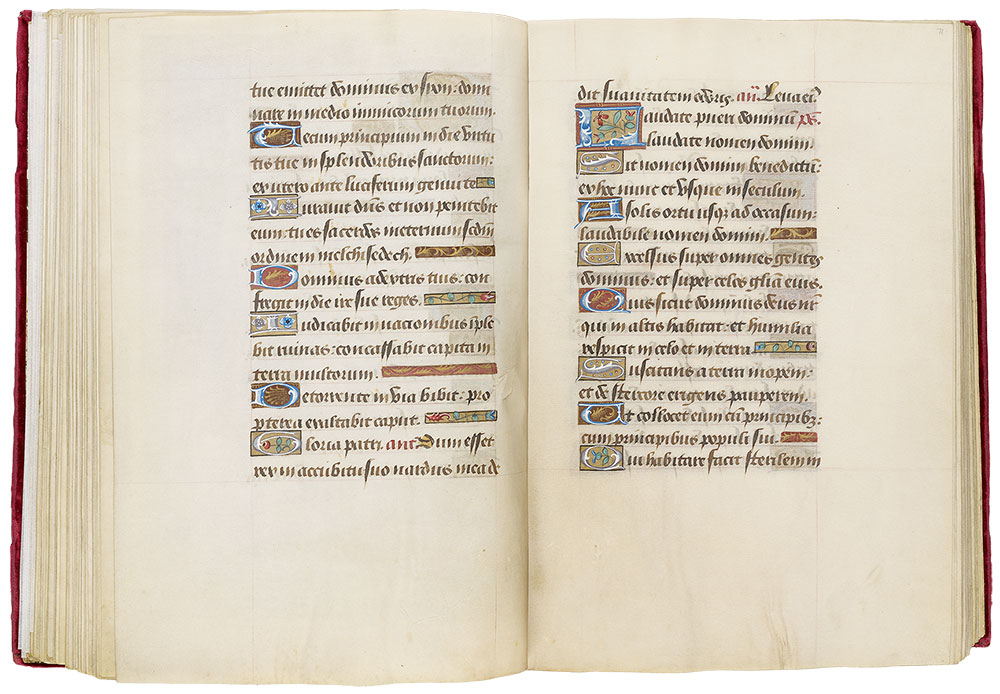
Hours of Henry VIII
Illuminated by Jean Poyer
Gift of the Heineman Foundation, 1977
MS H.8, fols. 71v–72r
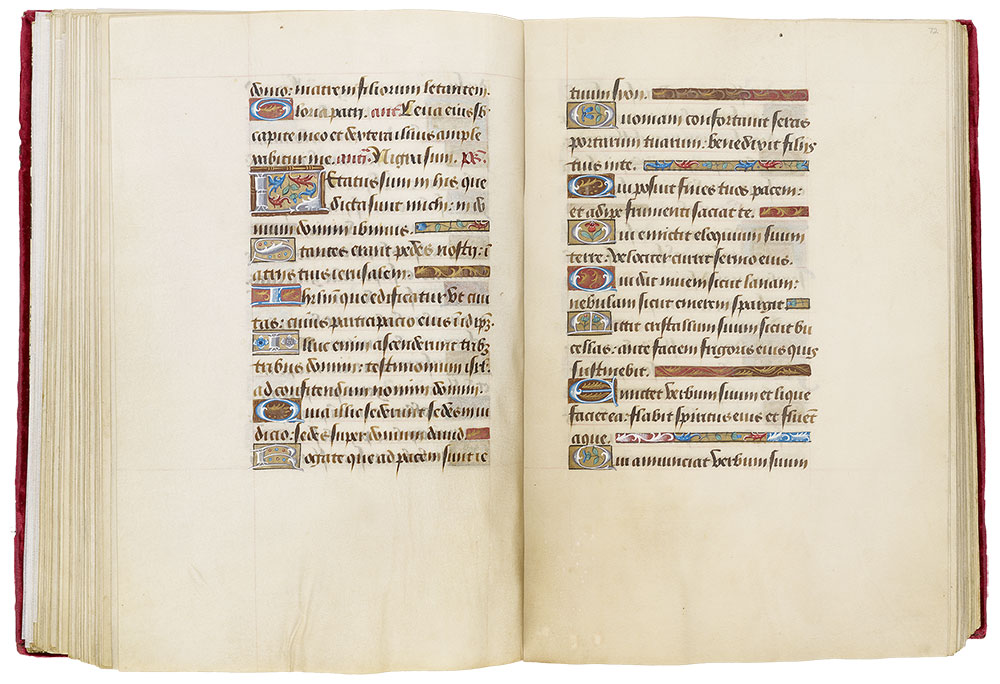
Hours of Henry VIII
Illuminated by Jean Poyer
Gift of the Heineman Foundation, 1977
MS H.8, fols. 72v–73r
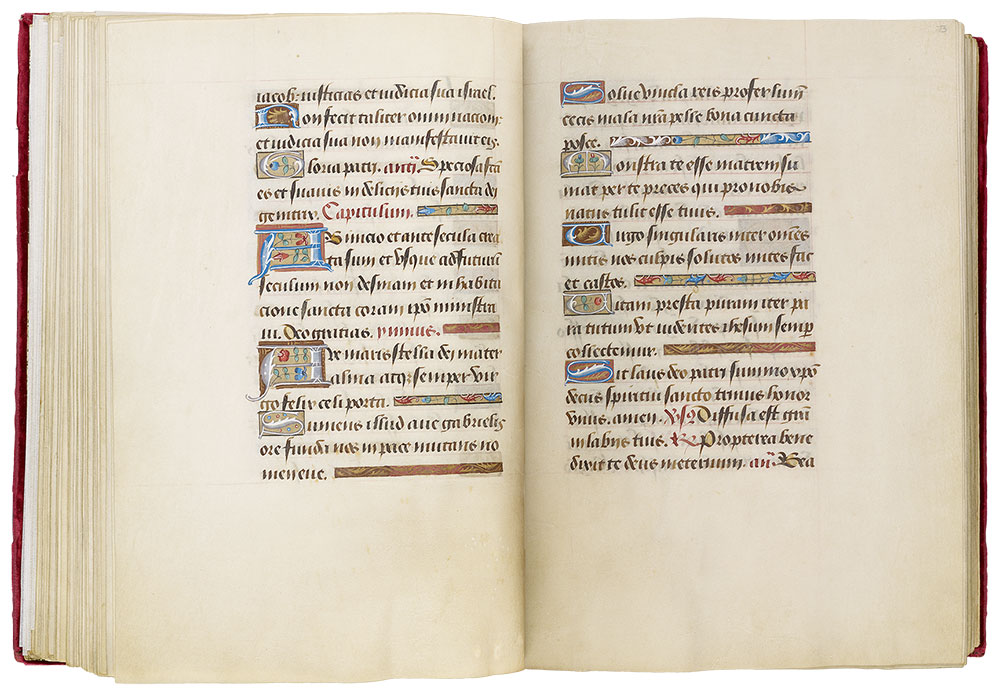
Hours of Henry VIII
Illuminated by Jean Poyer
Gift of the Heineman Foundation, 1977
MS H.8, fols. 73v–74r
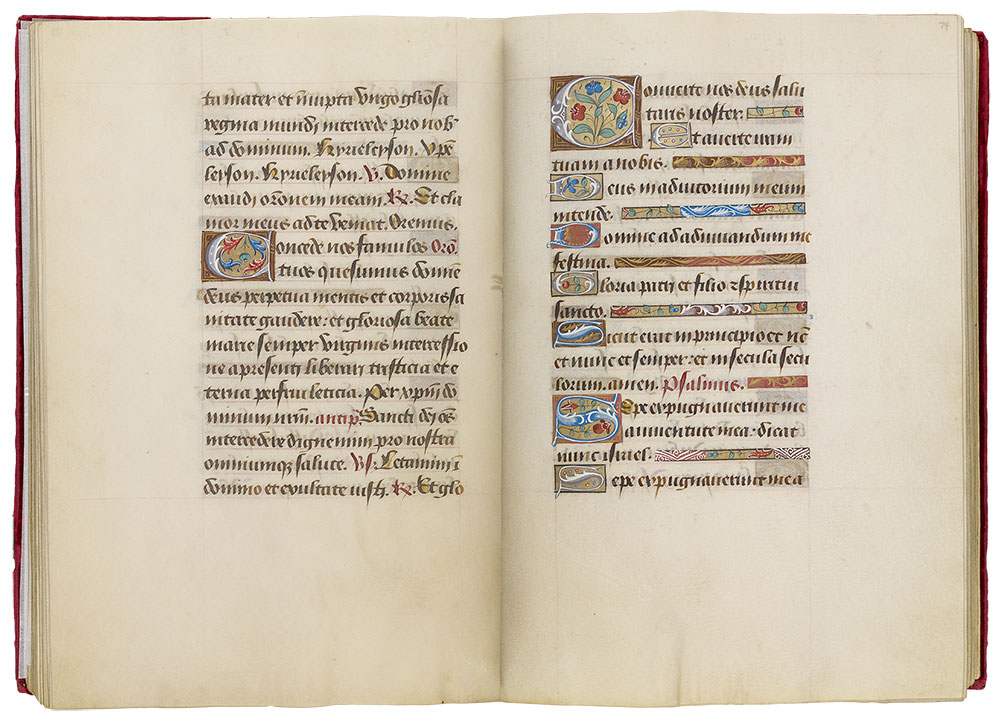
Hours of Henry VIII
Illuminated by Jean Poyer
Gift of the Heineman Foundation, 1977
MS H.8, fols. 74v–75r
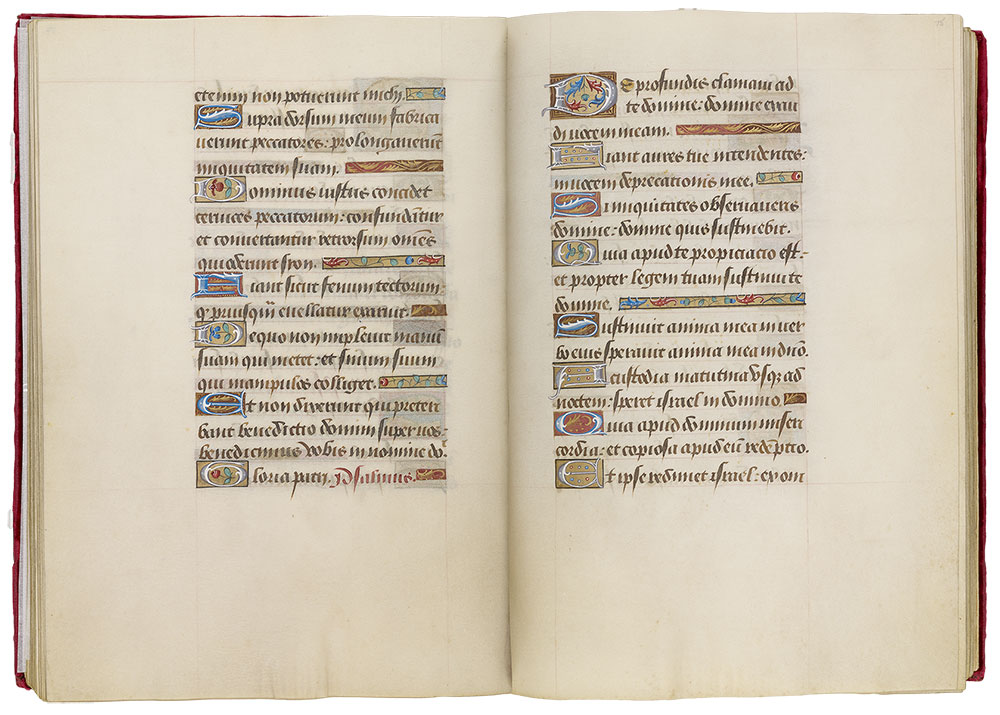
Hours of Henry VIII
Illuminated by Jean Poyer
Gift of the Heineman Foundation, 1977
MS H.8, fols. 75v–76r
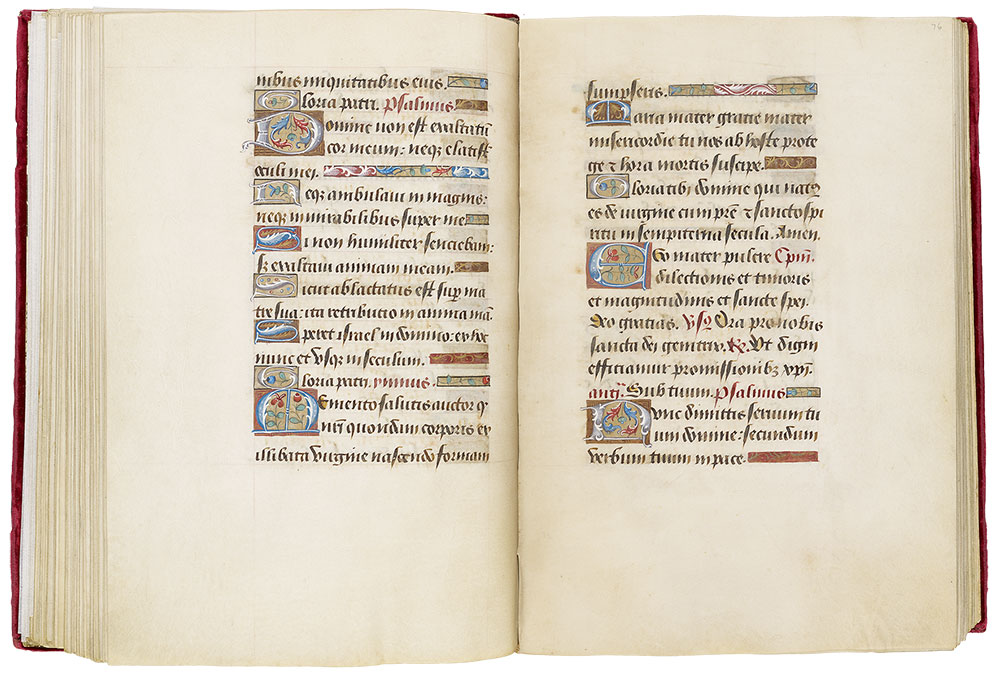
Hours of Henry VIII
Illuminated by Jean Poyer
Gift of the Heineman Foundation, 1977
MS H.8, fols. 76v–77r
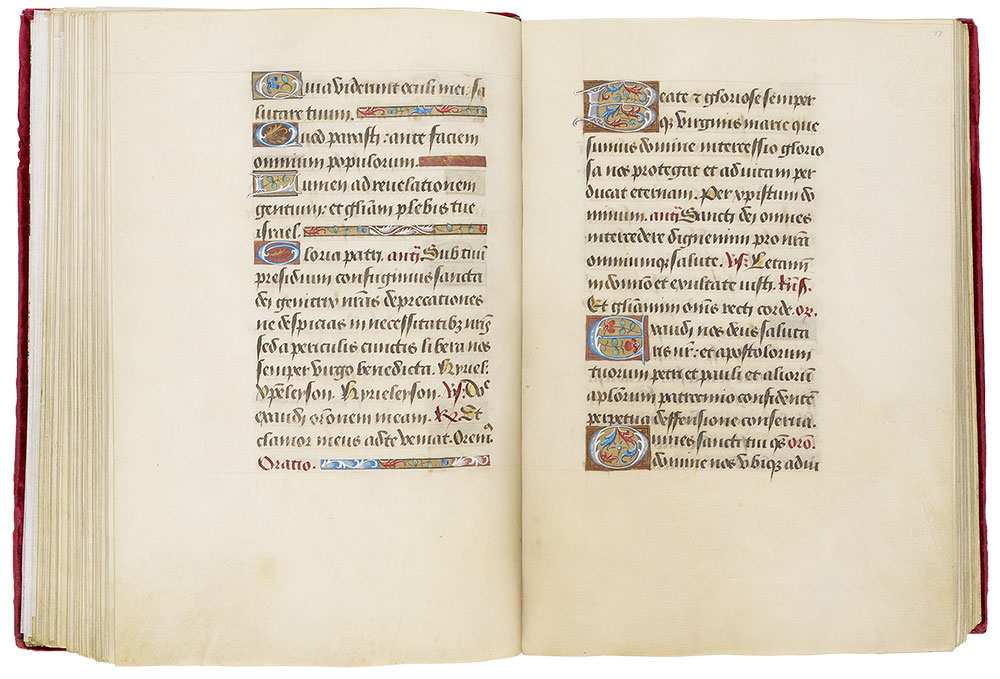
Hours of Henry VIII
Illuminated by Jean Poyer
Gift of the Heineman Foundation, 1977
MS H.8, fols. 77v–78r
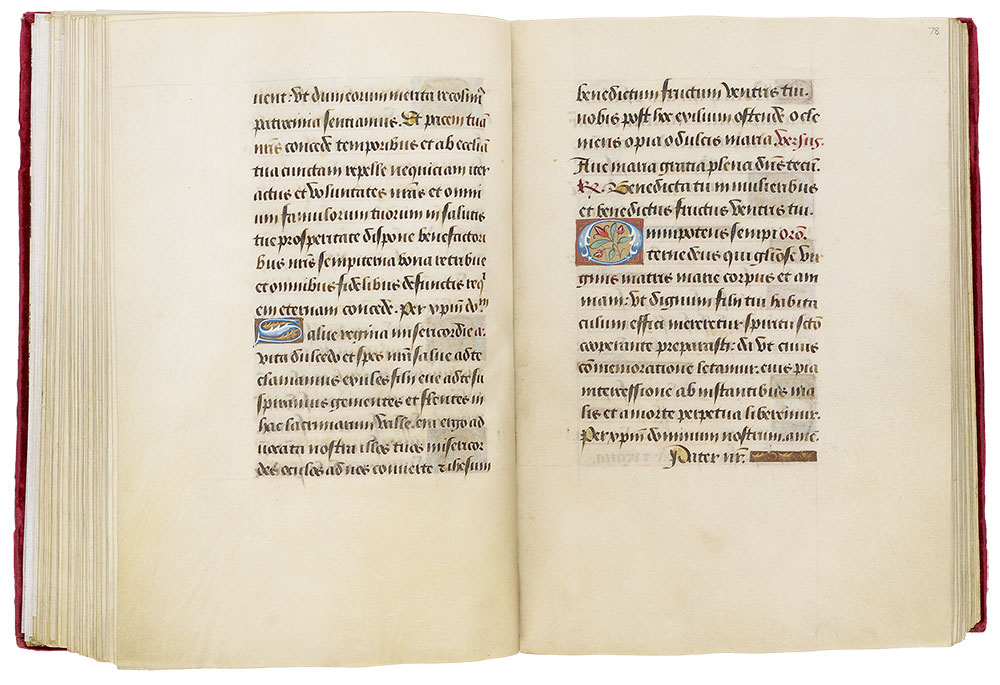
Hours of Henry VIII
Illuminated by Jean Poyer
Gift of the Heineman Foundation, 1977
MS H.8, fols.78 v–79r
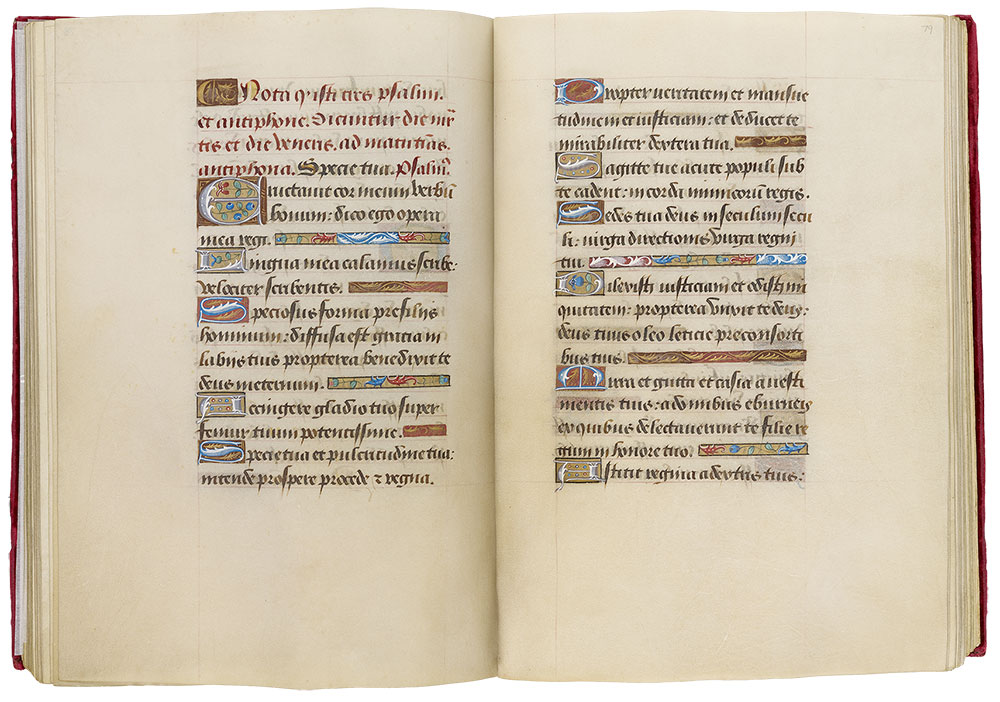
Hours of Henry VIII
Illuminated by Jean Poyer
Gift of the Heineman Foundation, 1977
MS H.8, fols. 79v–80r
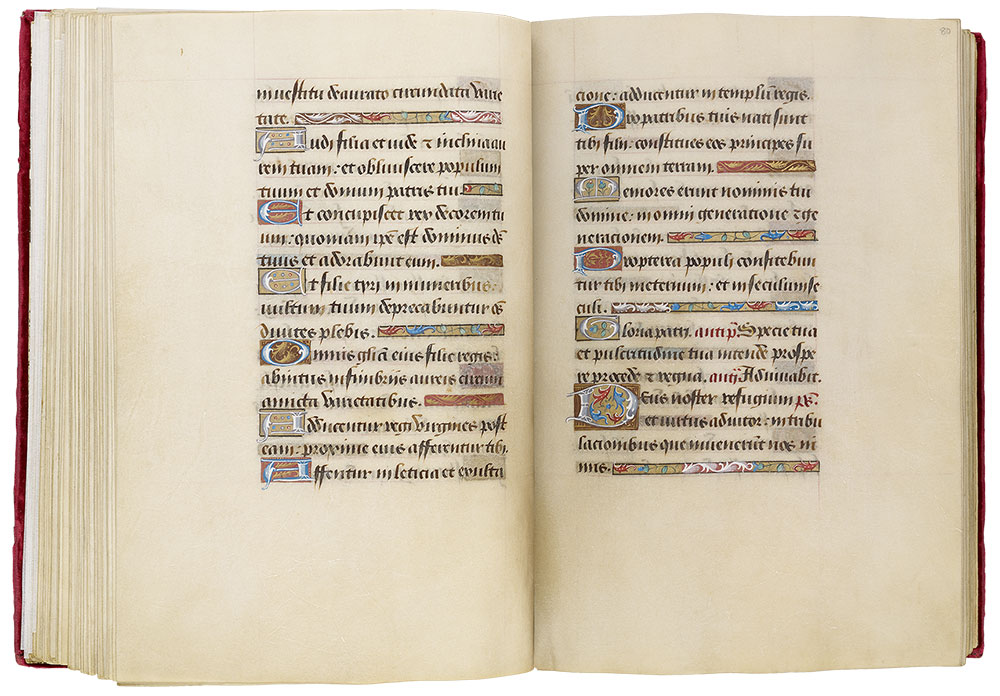
Hours of Henry VIII
Illuminated by Jean Poyer
Gift of the Heineman Foundation, 1977
MS H.8, fols. 80v–81r
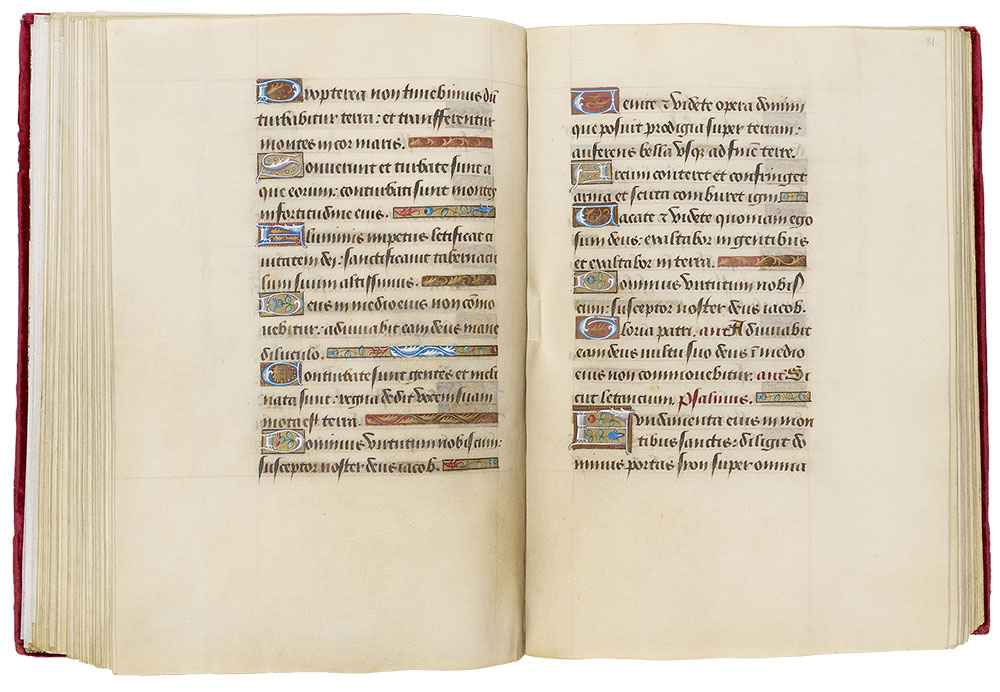
Hours of Henry VIII
Illuminated by Jean Poyer
Gift of the Heineman Foundation, 1977
MS H.8, fols. 81v–82r
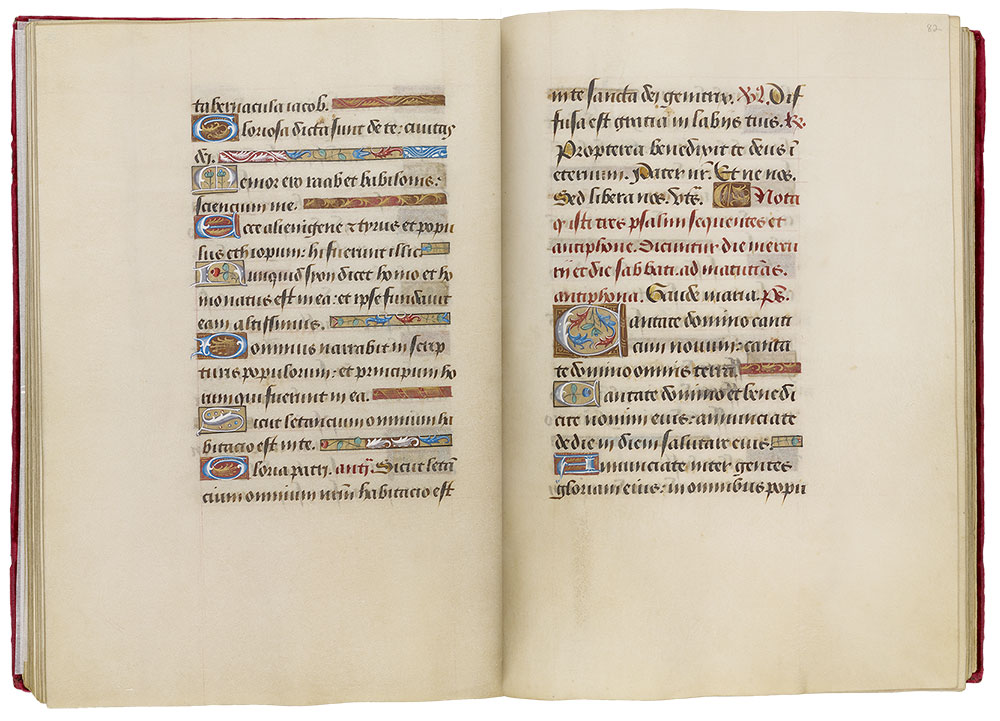
Hours of Henry VIII
Illuminated by Jean Poyer
Gift of the Heineman Foundation, 1977
MS H.8, fols. 82v–83r
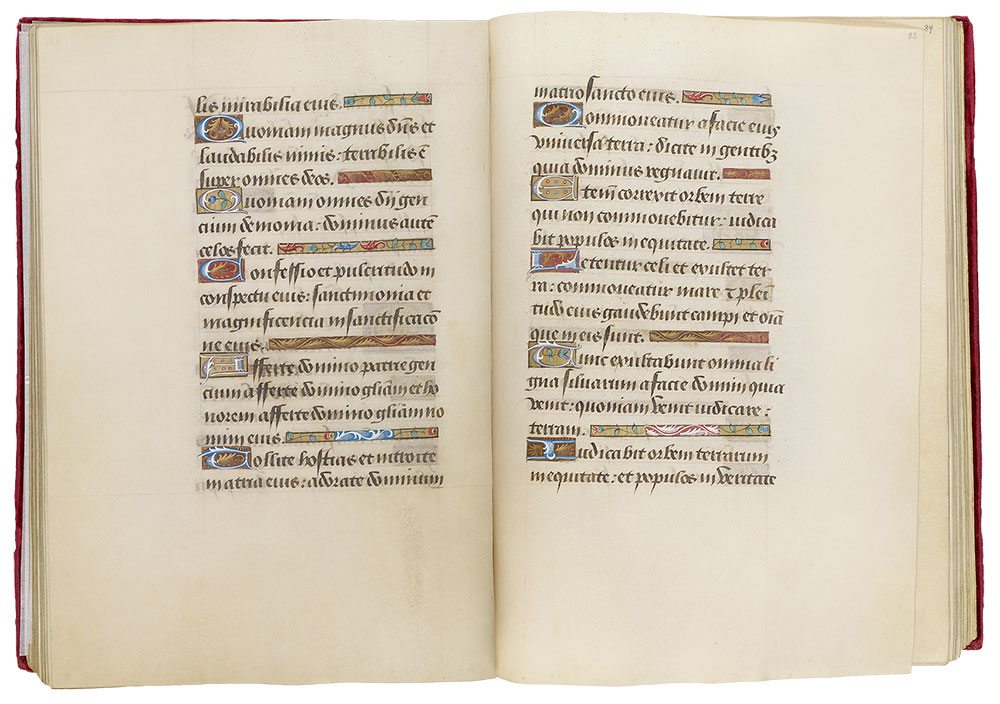
Hours of Henry VIII
Illuminated by Jean Poyer
Gift of the Heineman Foundation, 1977
MS H.8, fols. 83v–84r
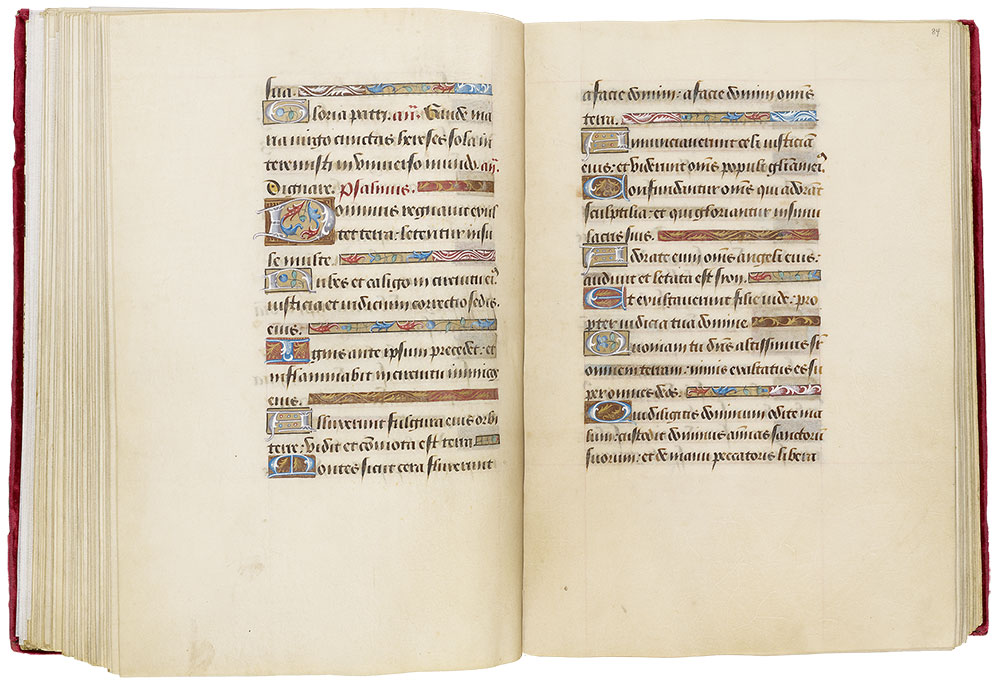
Hours of Henry VIII
Illuminated by Jean Poyer
Gift of the Heineman Foundation, 1977
MS H.8, fols. 84v–85r
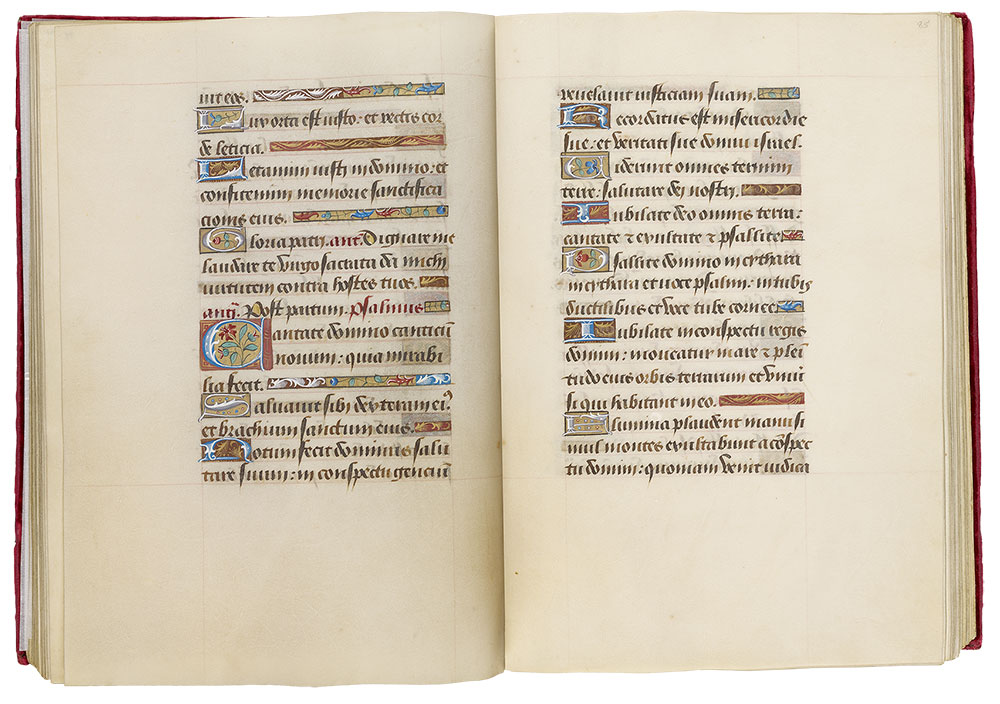
Hours of Henry VIII
Illuminated by Jean Poyer
Gift of the Heineman Foundation, 1977
MS H.8, fols. 85v–86r
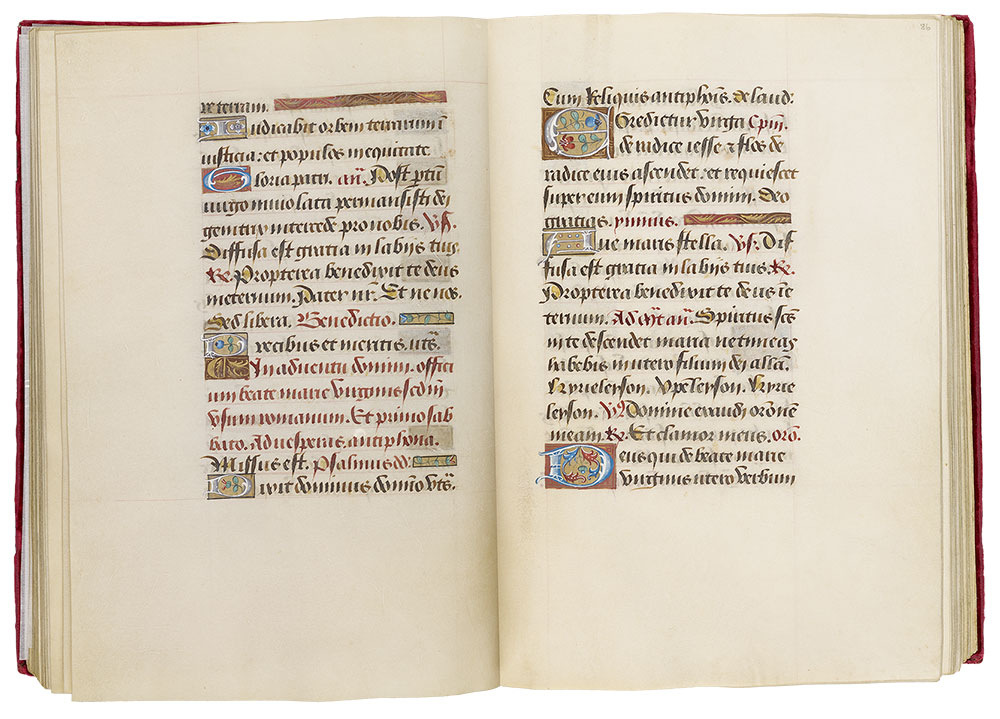
Hours of Henry VIII
Illuminated by Jean Poyer
Gift of the Heineman Foundation, 1977
MS H.8, fols. 86v–87r
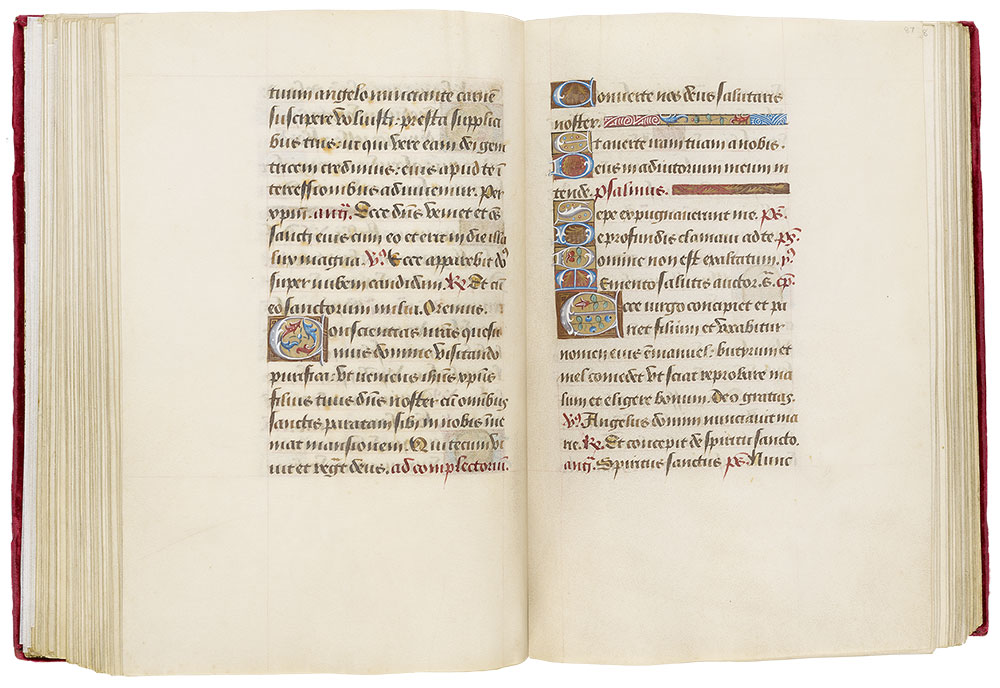
Hours of Henry VIII
Illuminated by Jean Poyer
Gift of the Heineman Foundation, 1977
MS H.8, fols. 87v–88r
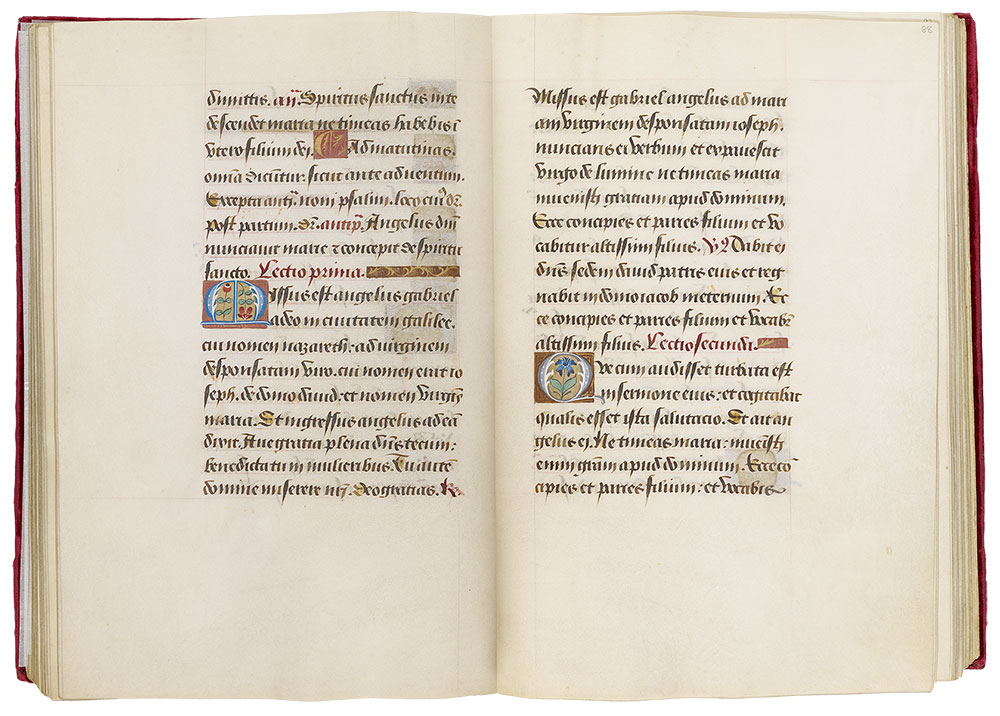
Hours of Henry VIII
Illuminated by Jean Poyer
Gift of the Heineman Foundation, 1977
MS H.8, fols. 88v–89r
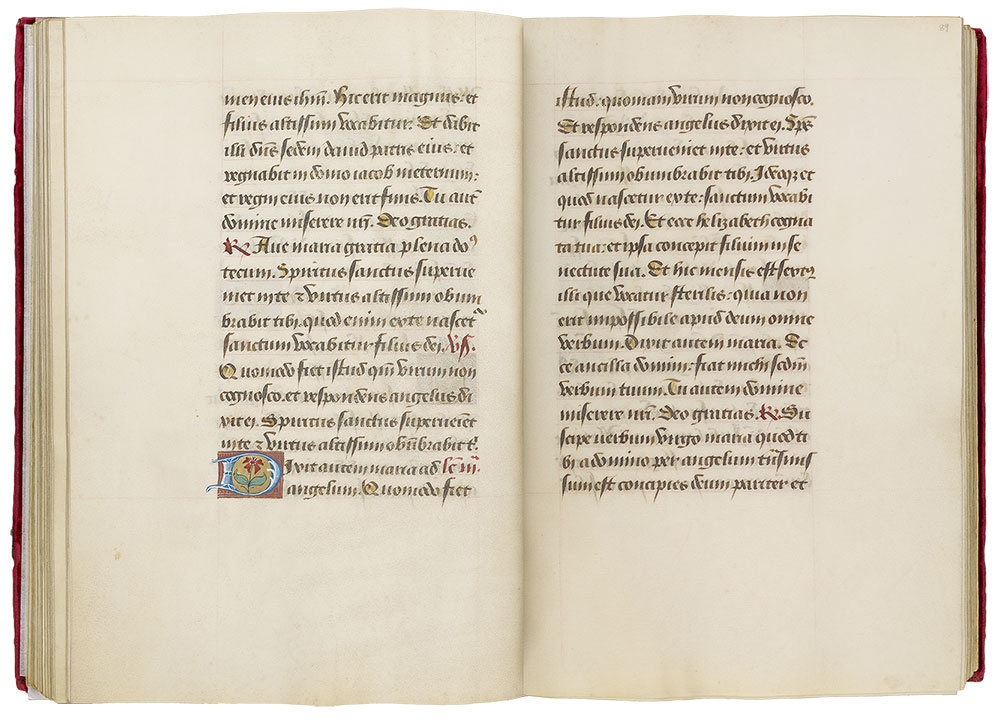
Hours of Henry VIII
Illuminated by Jean Poyer
Gift of the Heineman Foundation, 1977
MS H.8, fols. 89v–90r
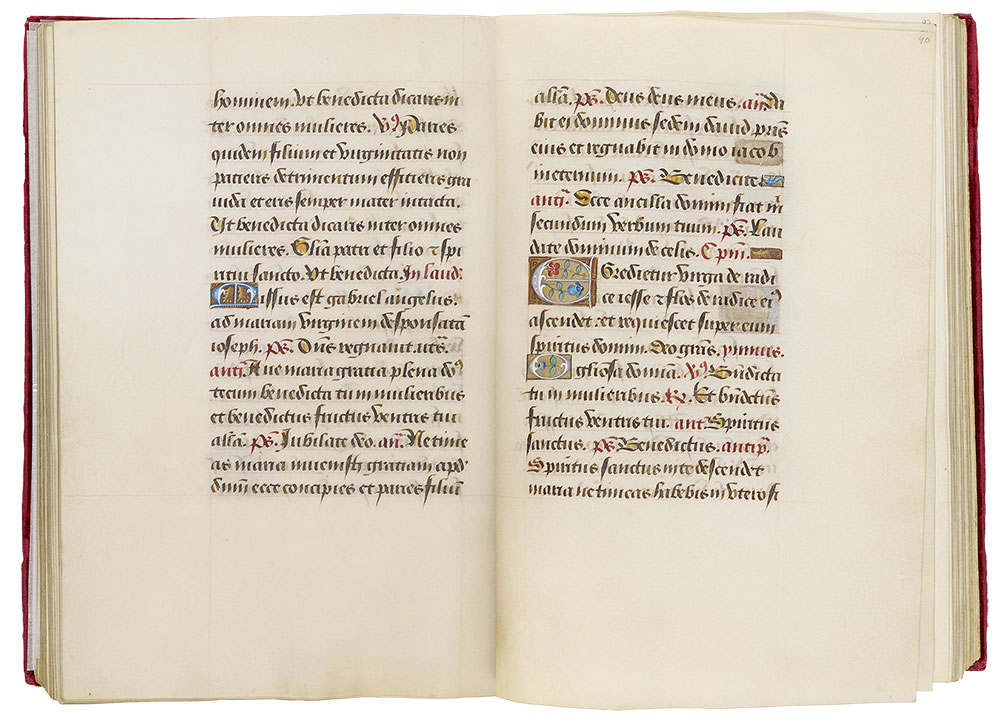
Hours of Henry VIII
Illuminated by Jean Poyer
Gift of the Heineman Foundation, 1977
MS H.8, fols. 90v–91r
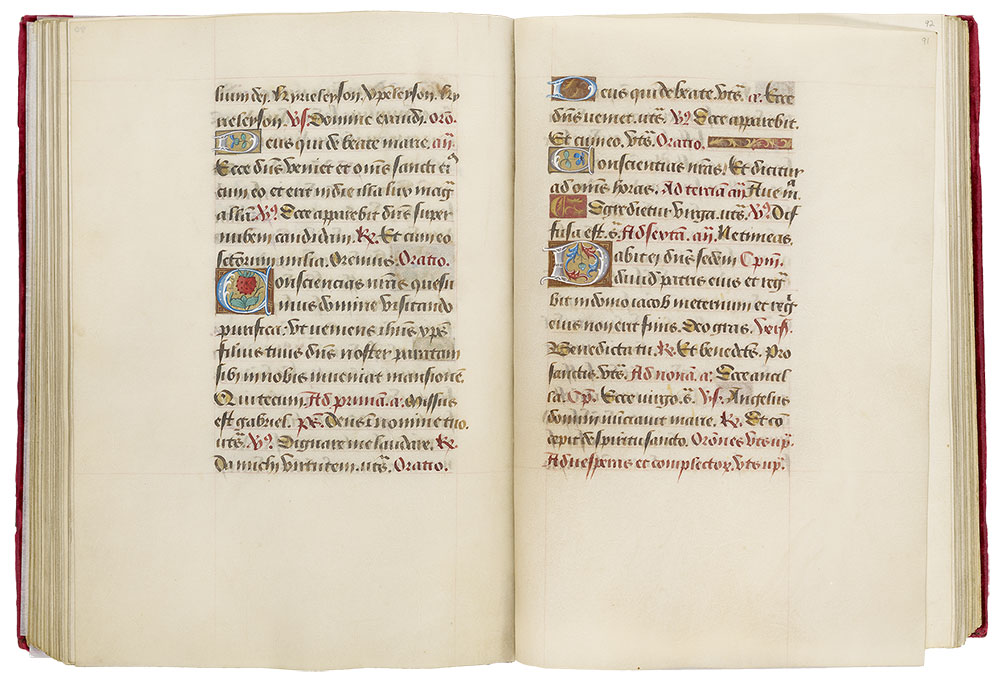
Hours of Henry VIII
Illuminated by Jean Poyer
Gift of the Heineman Foundation, 1977
MS H.8, fols. 91v–92r
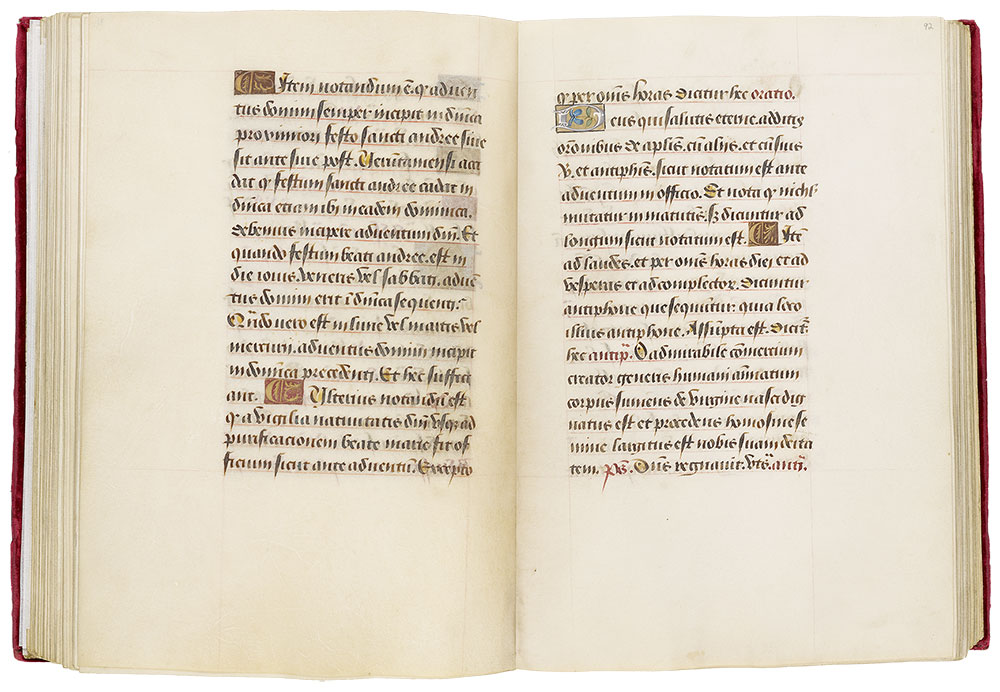
Hours of Henry VIII
Illuminated by Jean Poyer
Gift of the Heineman Foundation, 1977
MS H.8, fols. 92v–93r
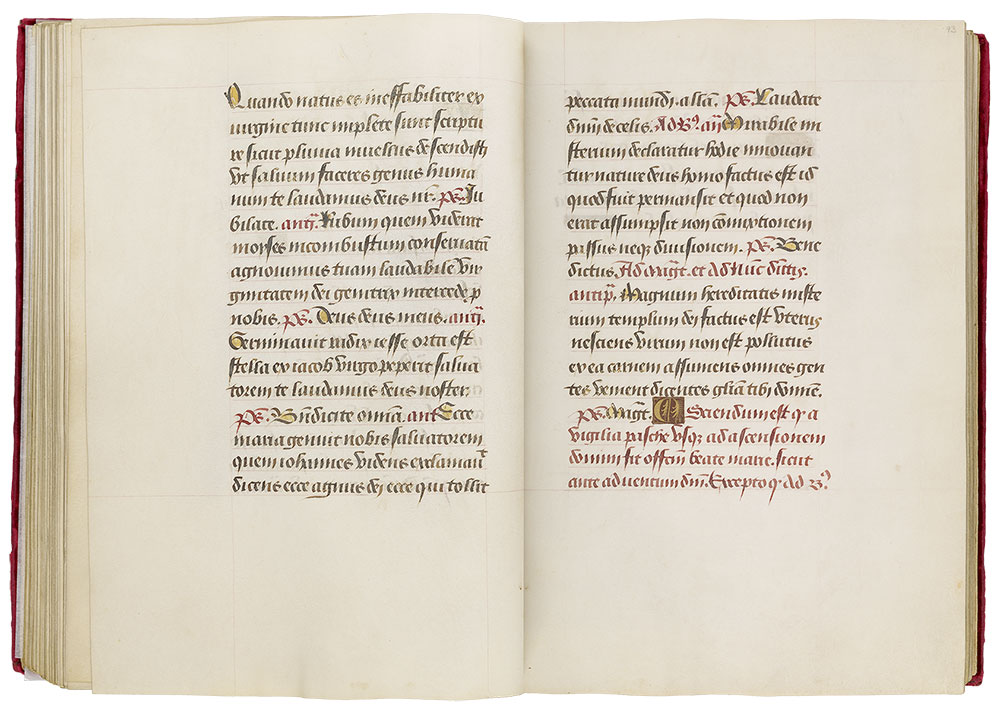
Hours of Henry VIII
Illuminated by Jean Poyer
Gift of the Heineman Foundation, 1977
MS H.8, fols. 93v–94r
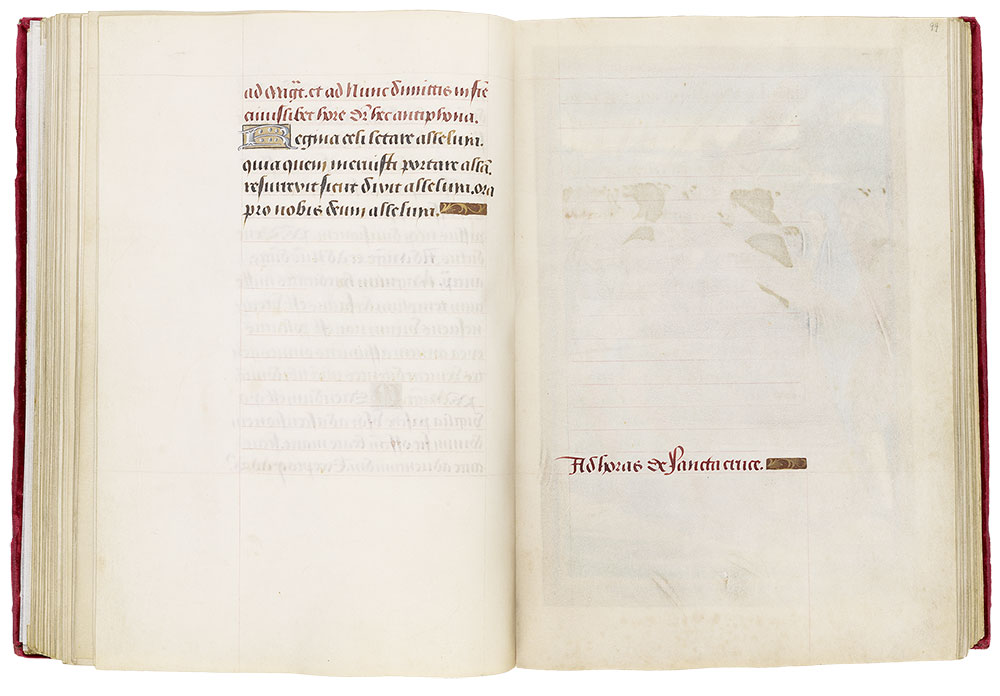
Hours of Henry VIII
Illuminated by Jean Poyer
Gift of the Heineman Foundation, 1977